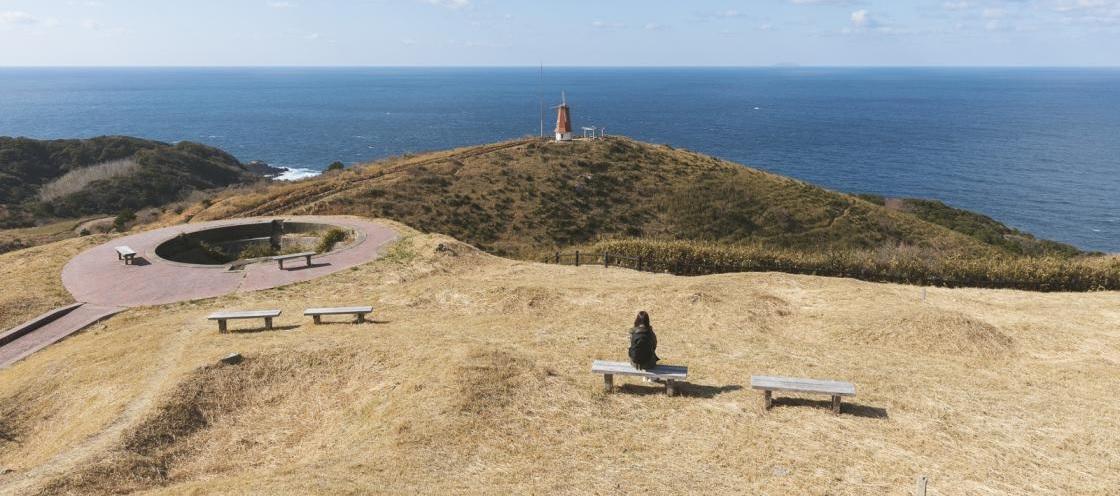
Kyushu Olle, To Munakata Oshima Island: A trip to the sea and mountains to experience a special world heritage site even before your walk.
The Munakata Oshima Island Course is where you can enjoy a special journey even before you start walking. In addition to it’s being an isolated island, it is also a land of faith that constitutes the world heritage site“Sacred Island of Okinoshima and Associated Sites in the Munakata Region.” During your visit, you can pray the Sacred Island Okinoshima from afar, depending on the weather. As you follow the island’s history to Nakatsu-gu, Okitsu-gu Yohaisho, and the remains of the Houdai Ato Battery, you will also be able to enjoy the sea and mountains. So, follow me as I walk the Kyushu Olle with the refreshing breeze of the sea.
〇Trekking time About 4-5hours
〇Altitude difference 200m
〇Distance 11.4km
〇Difficulty Medium to advanced
Take a ferry from Konominato port. It costs 570 yen to Oshima one way (290 yen for children)
The first step is the ferry
The Munakata Oshima course is very different from other areas because of the access to reach the site. Taking less than 30 minutes by the ferry, you’ll glide across the water as you are splashed and rocked by the waves on the observation deck.
Just leaving the port is becoming more like a trip.
The sunlight spilling through the clouds feels divine.
By the time I get to Oshima, I’m already looking back, thinking “This is going to be a good trip.” Thanks to the ferry, I felt like I have traveled, even though I haven’t walked yet.
When I get off at the terminal, Mt. Mitake, which towers over Oshima, welcomes me. This is the real start.
You can see the torii (gate of the shrine) in front of the mountain. Behind it is Nakatsu-gu, Muanakata Taisha Shrine.
It’s okay to start walking right away, but I decide to take a short detour —to the Munakata Fisheries Cooperative Oshima produce stand Sayoshima on the side of the terminal. You can easily find the local seasonal things such as fresh seafood or Amanatsu (sweet Watson Pomelo).
Considering the long way we’re going, we decide to take some food with us. We choose lightweight ones to easily take with us, such as Monaka (bean-jam-filled wafers) with Oshima’s salt, salt candy, and vinegared wakame seaweed.
Let’s find a scenic spot! It will make this local food extra delicious and increase the enjoyment of my trip.
When I shopped at “Sayoshima”, I got some beautiful shells.
The restaurant is only on the east side of the island where the ferry terminal is located. So, it might be a good idea to have your meal before starting. However, if you arrive at Oshima early, few shops may open.
For myself, I had a sashimi set meal at Kotobukiya Saburo, which was open from 10:00 am. Of course, it was very fresh!
Sashimi set meal with a full dish of fresh seafood for 1,500 yen.
Experience the legendarily magnificent view at Nakatsu-gu
After fortifying myself with food, I finally start walking. You can reach Nakatsu-gu Muanakata Taisha Shrine in five minutes by following the ribbon to the landmark. This enshrined Deity (The God of Ritual) is Tagitsuhime, one of the three daughter goddesses of Amaterasu Omikami. Muanakata Taisha Shrine is one of the oldest shrines in Japan, consisting of three shrines, Okitsu-gu, Nakatsu-gu and Hetsu-gu. Give a bow in front of the torii gate and step into the historic sanctuary.
Markers are written on the ground or stones as well as on the ribbon.
At first, it was a beach, so there were not hills, and I arrived at Nakatsu-gu in no time.
There was a marker for the “Milky Way” for the stream flowing through the precincts. In fact, Nakatsu-gu is said to be the birthplace of the Tanabata legend of the annual reunion of two lovers meeting at the Milky Way. Oshima is close to China and considering that Chinese culture was coming in across the sea, it is no wonder that it originated from there.
-
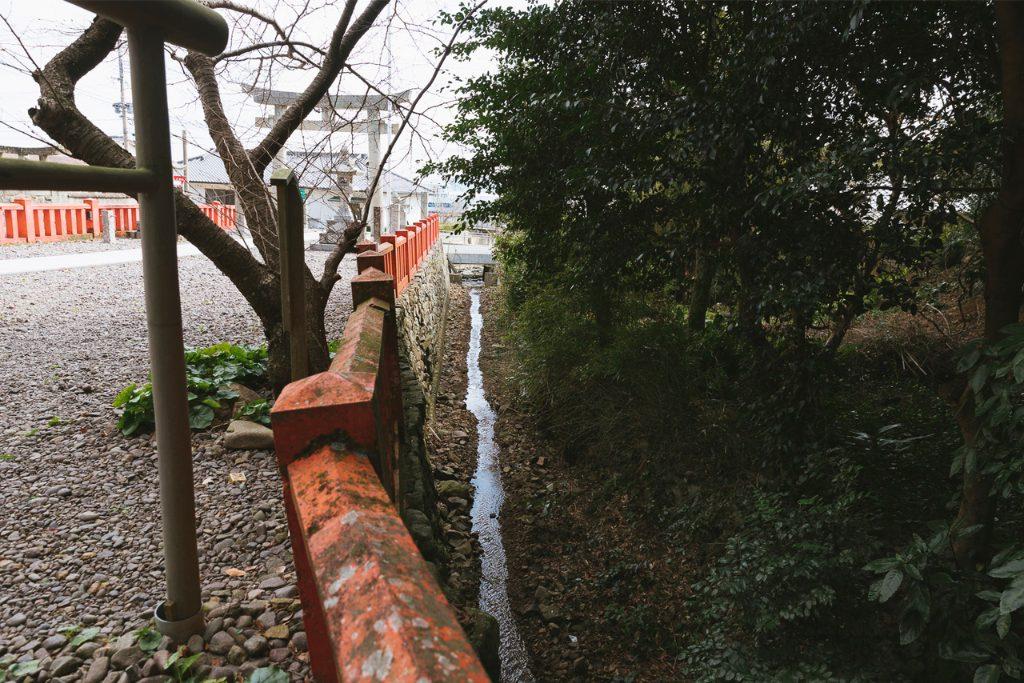
Unlike the “Milky Way” over the night sky, it flows modestly at Nakatsu-gu.
-
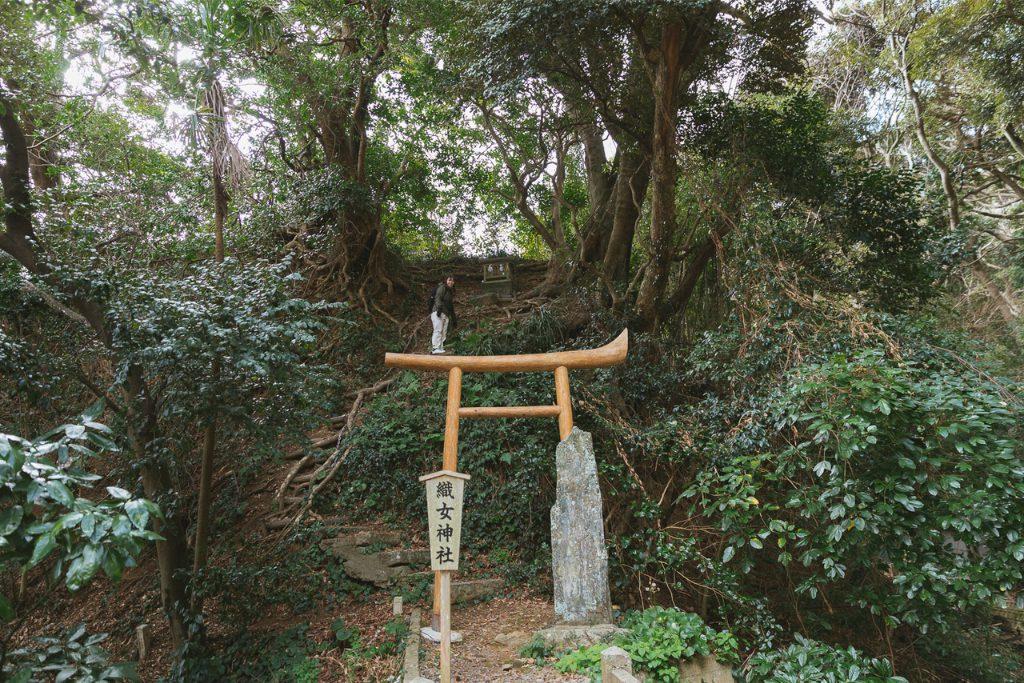
Orihime (Vega, the weaver girl) was enshrined on the other side of the Milky Way.
The Kengyu shrine is on the other side of Milky Way, next to Nakatsu-gu.
It is a World Heritage Site and also is the oldest shrine. It is not common for the legends of the Orihime (Vega, the weaver girl) and Hikoboshi (Altair, the cowherd) to be preserved. Even without such information, it was a very pleasant space.
I was halfway up the stone steps to the main shrine when I looked back.
The sea was shining like a path of light — a divine beauty was there in the casual scenery.
Pray at the main shrine located at the top of the stone steps. The shrine is said to bring good luck in marriage in accordance with the Tanabata legend.
After paying your respects, walk down the hill at the far left and you will arrive at the spring water “Amano Manai”. This sacred water, which is said to have longevity benefits, is soft to the palate.
Climbing to worship the island where the gods live
Go around the back of Nakatsu-gu precincts and aim for Mt. Mitake, the highest peak of Oshima. The mountain road leading from here to the summit is the most difficult part of the course. The footsteps are a pleasant mountain trail that many people have stepped on.
If you’re not enjoying the scenery, it is a sign that your pace may be too fast. There is still a long way to go. Take your time to catch your breath, feel the beauty of the greenery, and take a slow pace.
Follow the sign that says “Route” and go around behind Nakatsu-gu precincts.
Oshima used to be a “mountain” that rose from the bottom of the sea, and the entire island is a series of hills. If you feel unwell or injured at a difficult spot, you can turn back from the paved road. The course allows you to return to the harbor by following the nearby paved path. You can also take shortcuts depending on your fitness and physical condition.
-
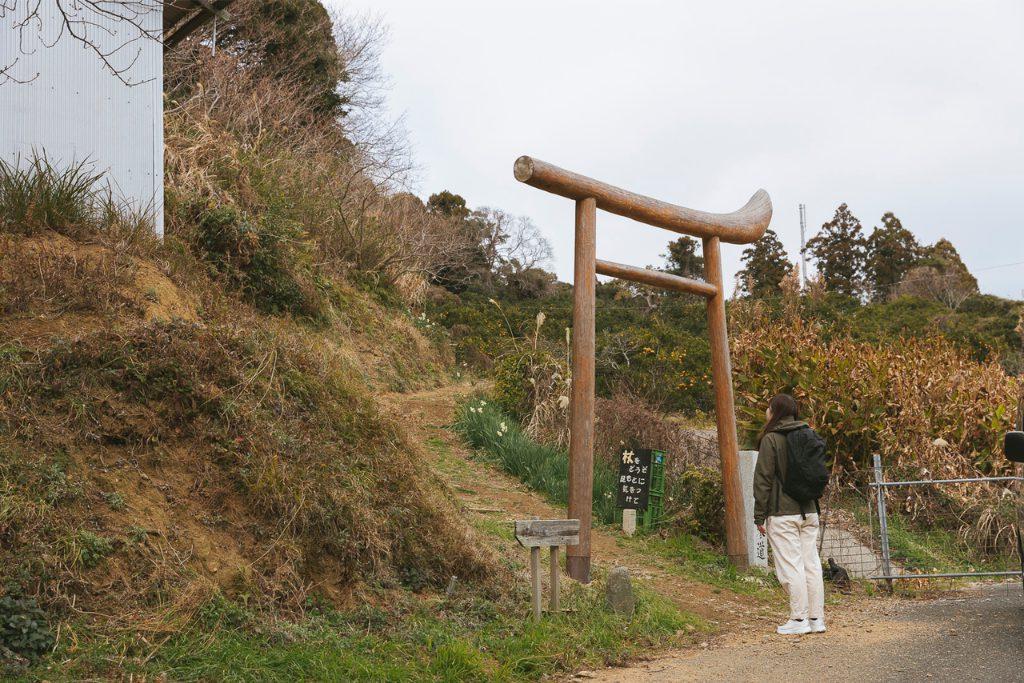
The torii gate and approach to Mitake Shrine at the top of the mountain. From here, an unpaved mountain trail continues.
-
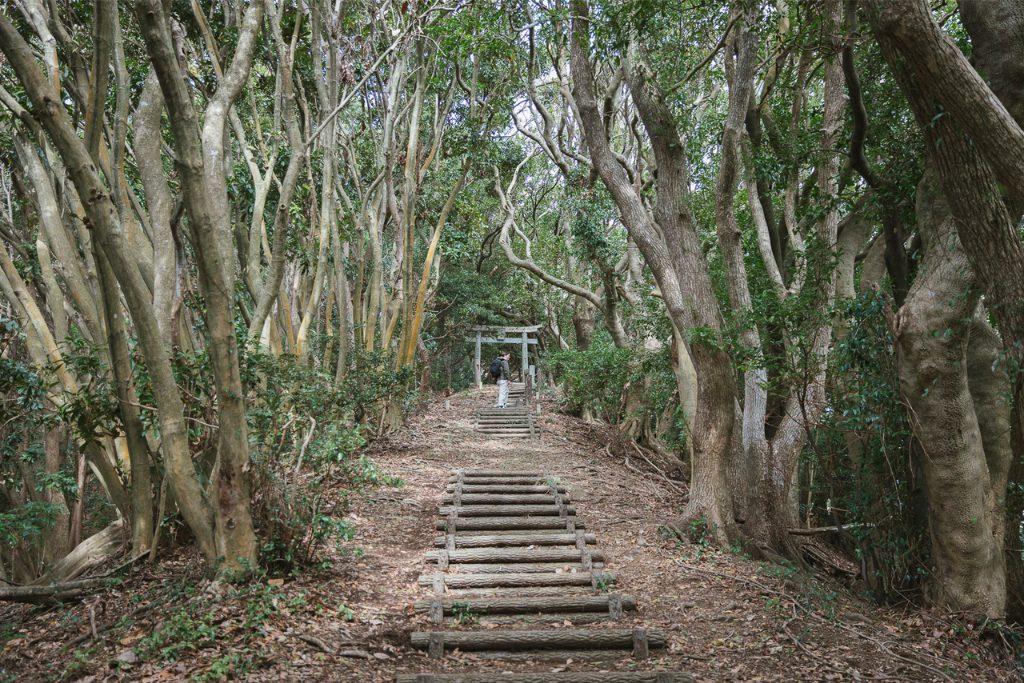
When we think of shrine approaches, we tend to think of coniferous trees. It is refreshing to see a natural forest.
After climbing the altitude difference of 200m from the coast, you will be rewarded with a magnificent view.
The pleasant seascape from the top of the mountain will bring a smile to your face.
It was a fine day, so I could see the sacred island of Okinoshima from the observatory. “Okinoshima” is best seen when the air is clear after the rain, and it may be foggy depending on the weather. I was delighted to have been given good luck, and I put my hands together at Mitake Shrine.
-
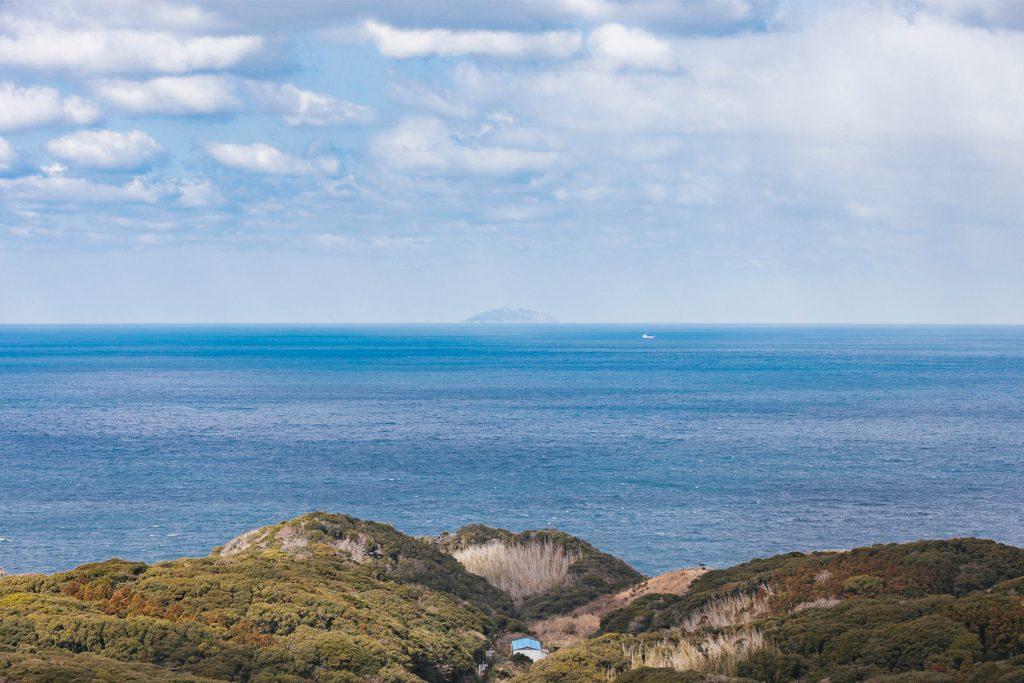
Okinoshima is faintly visible behind the horizon.
-
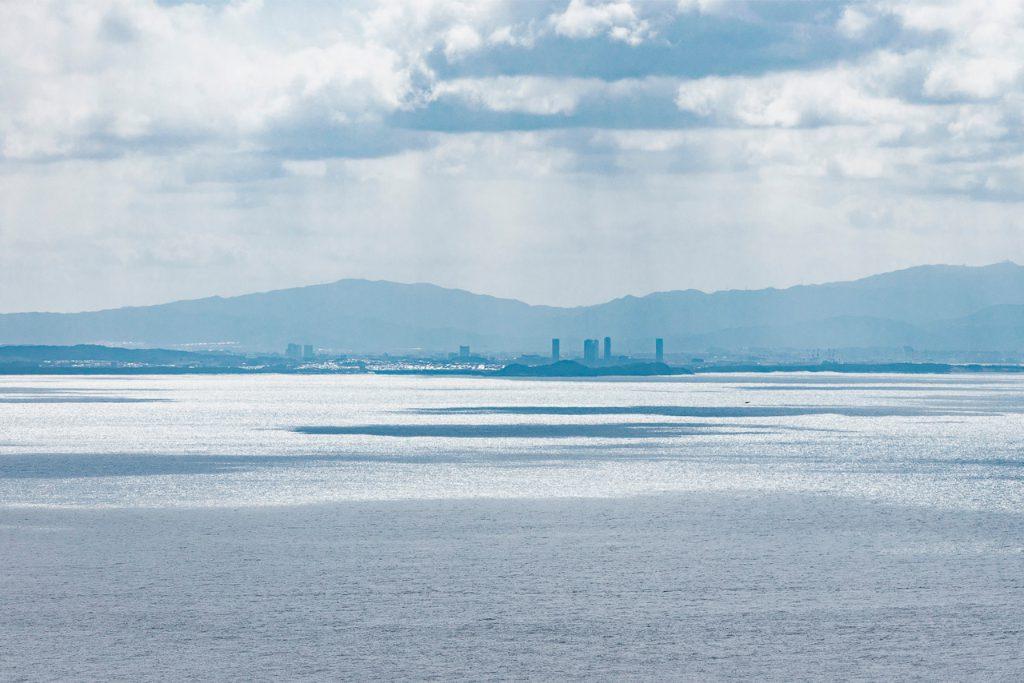
You can see the cityscape of Fukuoka city in the distance.
The Mitake Shrine at the top of the mountain is the Okumiya of Mitake shrine. It was surrounded by a mysterious atmosphere.
A series of scenes that feel like you’re not even in Japan
Enjoy the view to your heart’s content then go down the quiet forest road. There are no big climbs or steep descents from here. With the same calm feeling as the road, you will reach the northern part of the island.
There are few places to refill your water supply on the north side. During the hot season, you will want to be sure to bring more.
Turn right at the mountain trail exit of Mt. Mitake and reach the connection point 2.5km along the promenade. After climbing Mt. Mitake, I arrived in no time without any trouble.
-
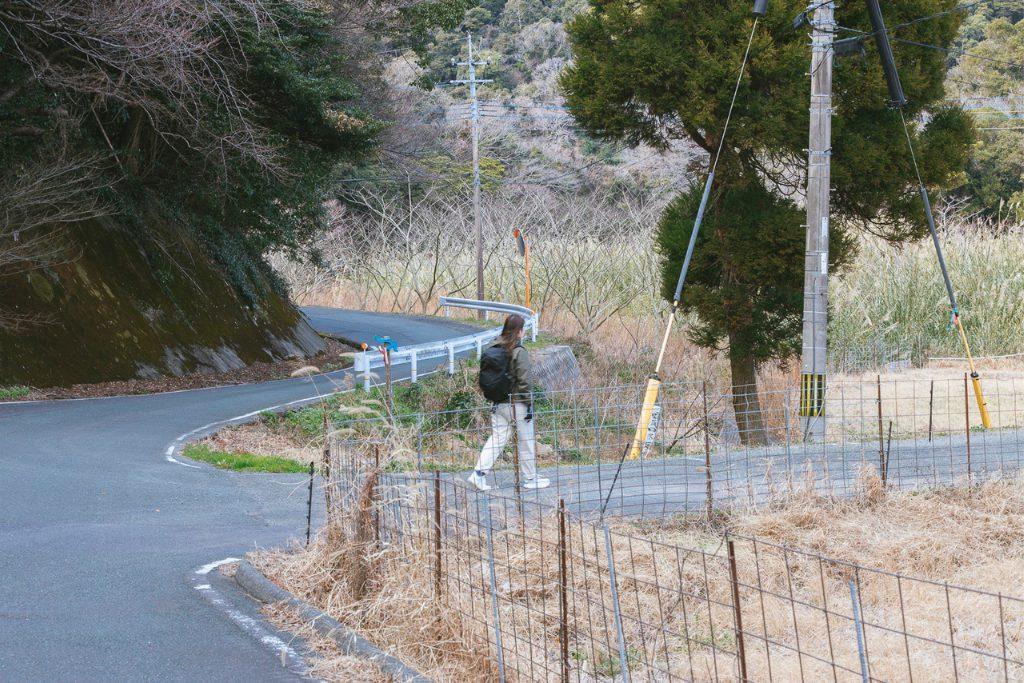
With asphalt, the pace of walking naturally increases.
-
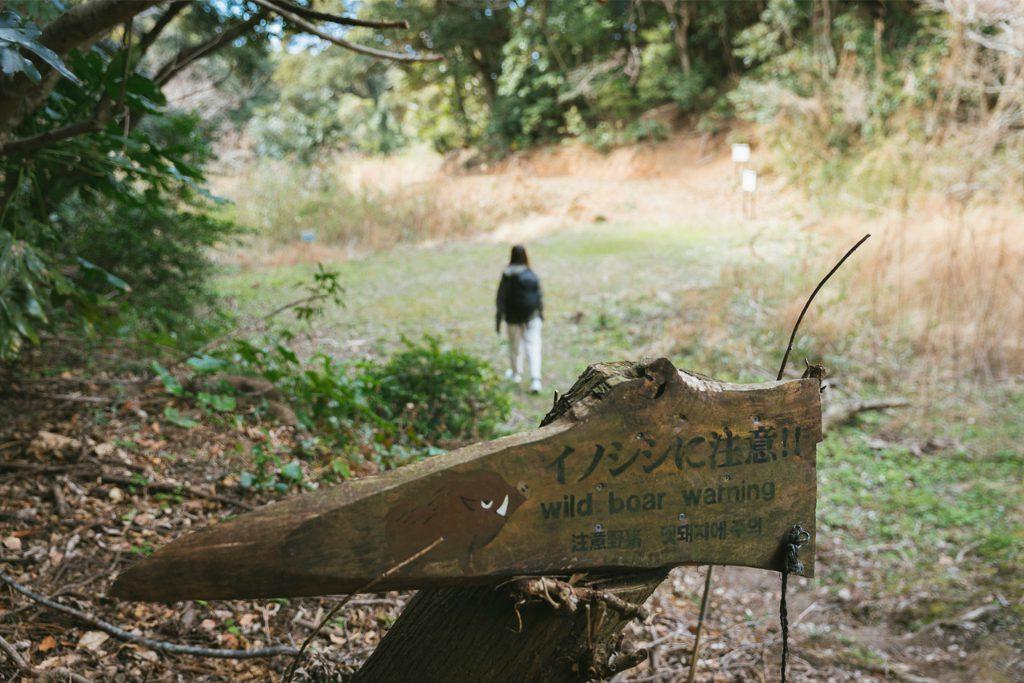
There was also a Nutaba (mud bath) where wild boars regularly bath in. Make loud noises and voices so that you do not encounter one in areas of poor visibility.
As we proceed to the building in the back…
Behind the promenade that stretches out into the grasslands is the tall windmill observation tower. The contrast between the reddish roof, blue sky, and the sea is beautiful, making you feel as if you have wandered into some other country. The scenery is picturesque no matter where you take your picture.
Around the Windmill Observatory, rape blossoms in spring, sunflowers in summer, and cosmos in autumn will entertain people.
-
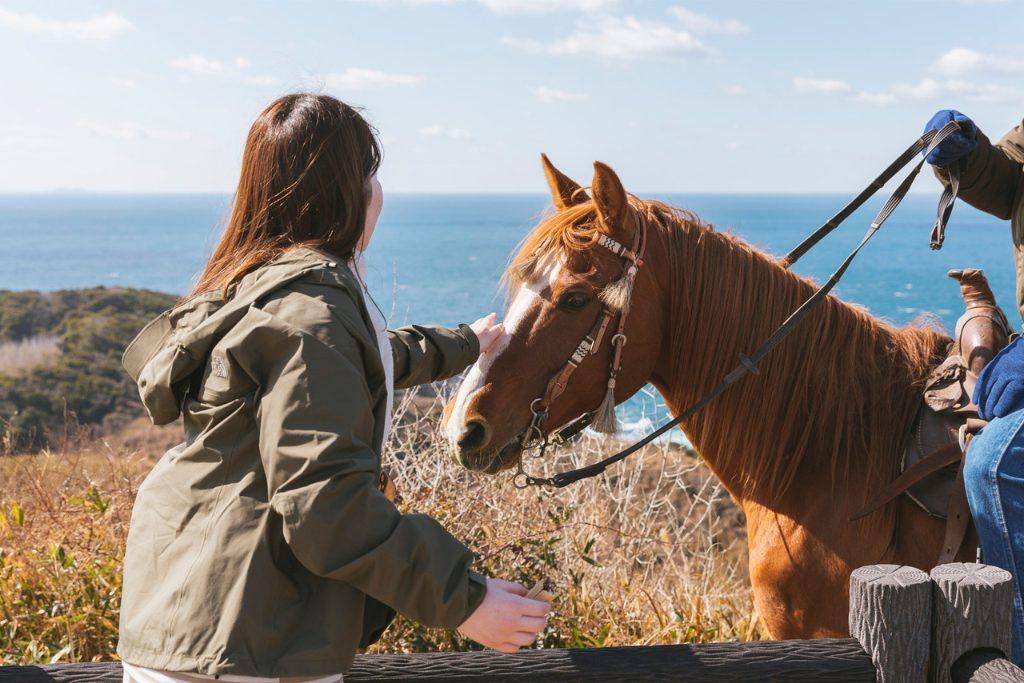
I meet a person who was just experiencing horseback riding, and it became a different space that makes me forget more and more that I am in Japan.
-
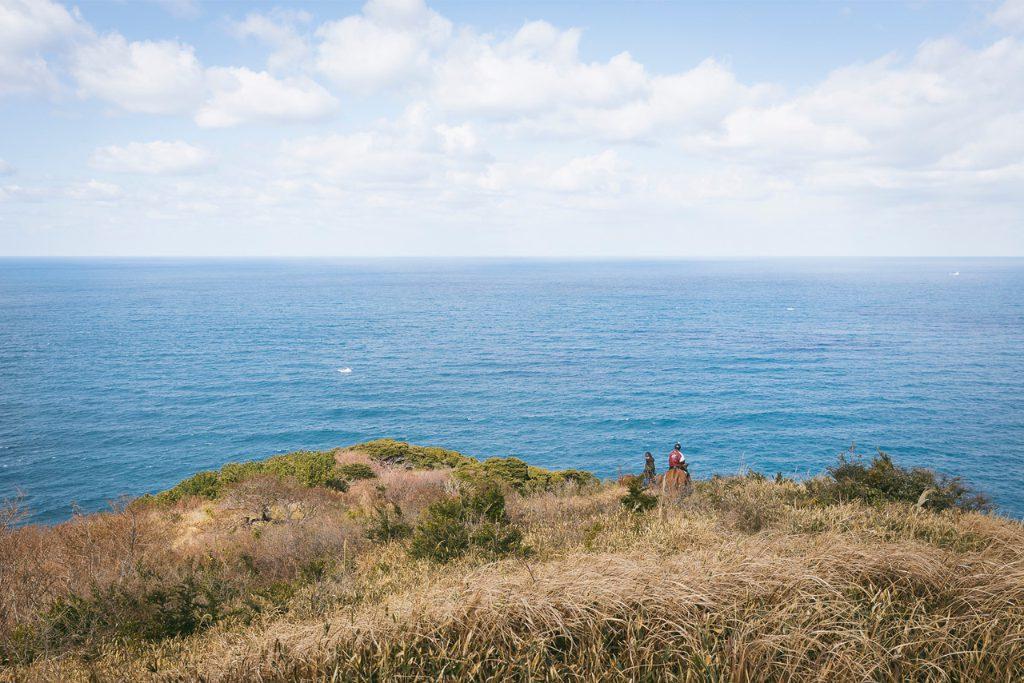
Riding a horse while looking at the horizon will be a wonderful experience that you will never forget.
Near the windmill is also the remains of a battery built in 1936. The part where the cannon was equipped was one step lower than the surroundings. After World War II, it was no longer used, and only the concrete foundation remains, which is still open.
The observation post beside the ruins of the gun emplacement also shows what it looked like in those days. It is characterized by the observation windows that were set up to measure the distance and speed of enemy ships. It is very long horizontally, and the sea seen from there emphasizes the horizon line, giving it a strange appearance.
The Genkai Sea from the observatory also had a special beauty.
It’s snack time while looking at the sea. I will have the Munakata Monaka that I bought earlier. The sweetness of the Monaka permeates my tired body. The anko (bean-jam-filling) and monaka with salt from Oshima are packaged separately, so it’s crispy and moist.
After enjoying the magnificent view, head to the highlight of Okitsu-gu Yohaisho. It is a place set up to worship Okinoshima, where landing on the island is prohibited. “Sacred Island” means that the island itself is the object of gods and worship and is strictly protected.
While most shrines have a main shrine in front of them after climbing stone steps, here at the Okitsu-gu Yohaisho, the main shrine stands horizontally facing the direction of Okinoshima Island.
I was staring off into Okinoshima over the horizon. People long ago would have seen it the same way and thought about Okinoshima and prayed. It’s strange that you can still do the same thing and feel the same.
Finally, I turn back for the ferry boarding time.
Be sure to return in time to catch the ferry. If you are in a hurry, you can take a shortcut by walking to the south instead of turning right from the parking lot of the Okitsu-gu Yohaisho. You can also return to the harbor faster if you go straight at the crossroads past the Oshima Community Center.
If you have time to spare, you can go out to the southern shoreline and enjoy the sea breeze. Yume no Sayoshima, with its vermilion torii gate, can be visited on foot at low tide. Likewise, the Ebb Island, which can only be crossed when the tide is low, was like Mont Saint-Michel, a World Heritage site. The natural and beautiful scenery of Oshima continues until the end of the tour.
You can climb the Yume no Sayoshima and worship the shrine.
-
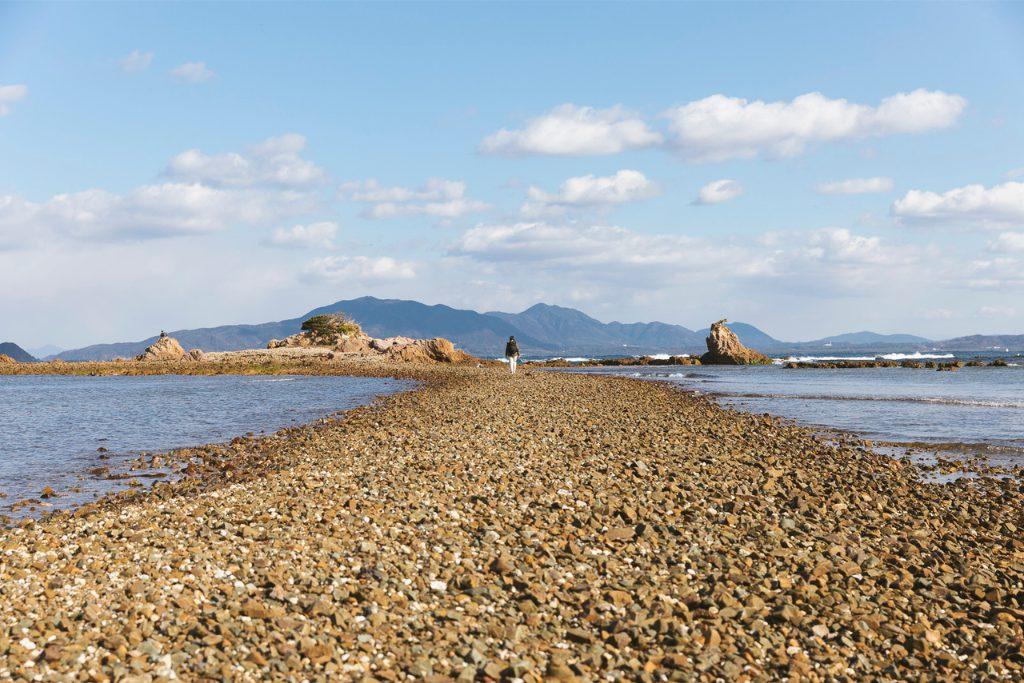
I was lucky enough to cross the tide!
-
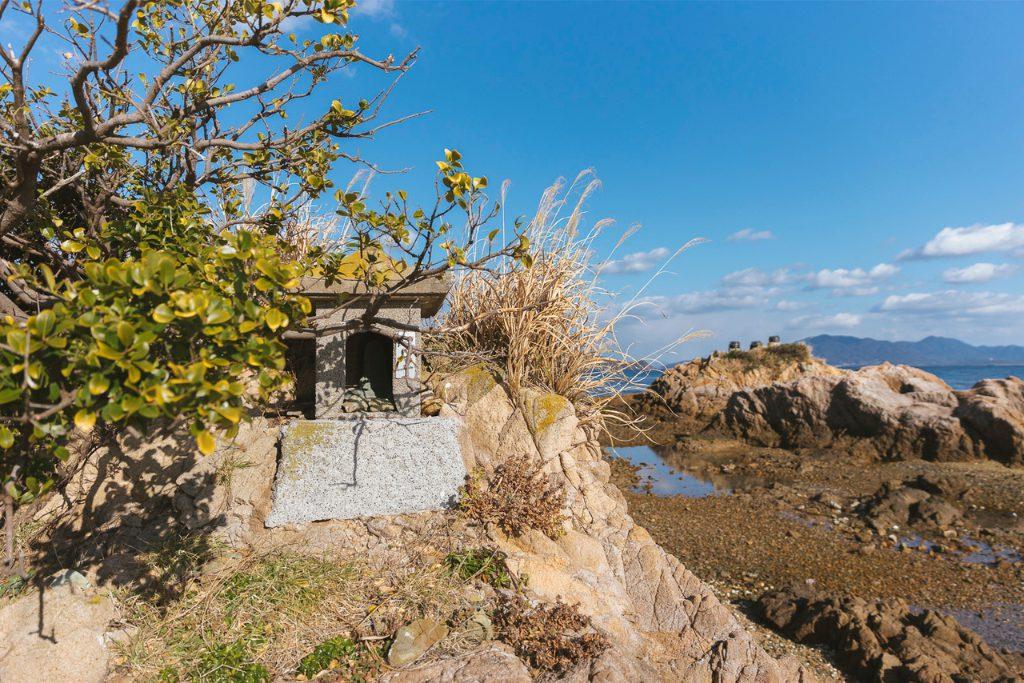
Worship in the Kansu as well. It was a walking trip to put hands together with God until the end.
If you are careless on the way back from the Okitsu-gu Yohaisho, you may miss a landmark and unknowingly take a shortcut. If you want to walk the Olle course all the way to the end, please be careful. I am ashamed to admit that I was so busy talking that I walked right past it. The same is true in other places, but when you find a landmark, be sure to confirm it by pointing to it or saying it out loud. If you accidentally go the wrong way, you may have to go back a considerable distance.
While I returned to the terminal and waited for the ferry, I healed my tiredness with a gelato with Oshima’s Amanatsu citrus.
Worship in the Kansu as well. It was a walking trip to put hands together with God until the end.
Walk from sea level to the highest mountain, Mt. Mitake, and traverse the island from north to south. It was a trip full of history and nature, visiting places of worship that have been carefully protected since ancient times. We were sure to have enjoyed the trip to the fullest, but when the ferry left the harbor, we felt a little sad. It was the same boat as the one that took us there, but I felt the complete opposite. We left the island with our hair pulled back, thinking we would come back again.
Upcoming (Spring) Highlights
-
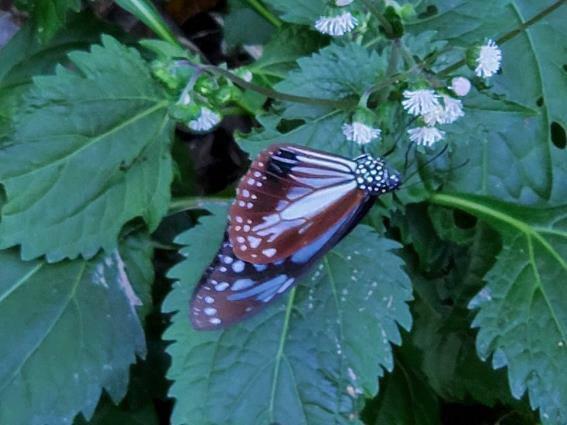
Coming flying Chestnut tiger butterfly
The Chestnut tiger butterfly is a migratory butterfly that travels from south to north from spring to summer. It will fly to Munakata City from April to May. You may be able to meet beautiful wing-patterned butterflies flying in a flock.
-
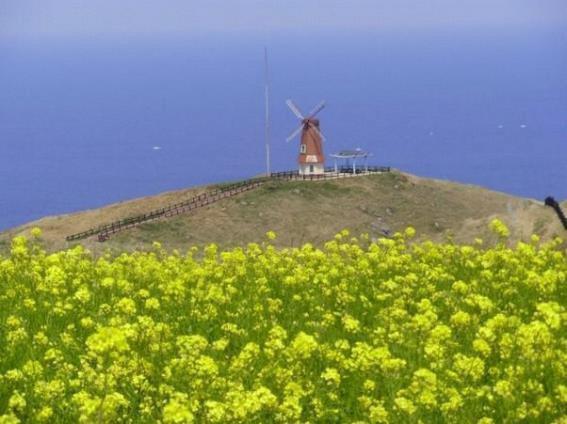
Windmill Observatory / Battery Site
In the spring, the fields of rape blossoms are colorful around the windmills and battery ruins that make you feel the history. You can enjoy the changing seasons such as sunflowers in summer and cosmos in autumn, and it is a romantic spot with a panoramic view of the Genkai Sea.
Spot Information
■Kitchen KAIKYU
901-9 Oshima, Munakata City, Fukuoka Prefecture(Google Map)
+81-940-72-2022
https://www.kaikyu.jp/ (Japanese Website)
It is a cafe where you can enjoy freshly made hot sandwiches while looking out at the beautiful sea. You can also pre-order lunch boxes for your journey.
■MUSUBI CAFE
773 Oshima, Munakata City, Fukuoka Prefecture(Google Map)
+81-90-5924-9491
https://oshimacafe.com/cafe/musubi-cafe/ (Japanese Website)
It is a trendy cafe with a panoramic view of the sea in front of the beach. Shakes and lemonade made with Amanatsu, a specialty of Oshima, are popular. Since it is an irregular holiday, it’s a good idea to contact them before visiting the cafe.
■Haru no hi
1876 Oshima, Munakata City, Fukuoka Prefecture (Google Map)
+81-70-8310-0879
https://meshidokoro-harunohi.com/ (Japanese Website)
A restaurant is run by a fisherman. They will treat you with dishes with fresh ingredients from the island.
■Kotobukiya Saburo
1645 Oshima, Munakata City, Fukuoka Prefecture(Google Map)
+81-940-72-2632
You can eat a sashimi set meal using local fish, a seafood bowl, and a luxurious lunch with seasonal fish.
■Canadian Camp Riding Club
2804-1 Oshima, Munakata City, Fukuoka Prefecture(Google Map)
+81-940-62-1912
https://oshima.canadiancamp.jp/ (Japanese Website)
There is a 21,000 m2 Yorouma (old age horse) / breeding ranch near the Windmill Observatory / Battery Ruins. Even beginners can enjoy horseback riding experiences. They have set up a water server for Olle customers. (Don’t forget money for tips).
■Oshima Koryu-kan
901-4 Oshima, Munakata City, Fukuoka Prefecture (Google Map)
+81-940-72-2797
http://searoad.city.munakata.lg.jp/oshimakouryukan/index.html (Japanese Website)
This is a facility where you can learn about the world heritage site, “Sacred Island of Okinoshima and Associated Sites in the Munakata Region.” If you learn the island’s charm and go around the course, you can enjoy Olle more.
■Munakata Fisheries Cooperative Oshima produce stand “Sayoshima”
1809-8 Oshima, Munakata City, Fukuoka Prefecture (In front of Oshima Port Ferry Terminal)(Google Map)
+81-940-72-2666
https://www.sayoshima.jp/ (Japanese Website)
Located on the ferry terminal side, you can buy seafood from Oshima. It is useful as a place to buy light meals and souvenirs for your trip.
Access
Fukuoka Airport, Hakata Port → Subway → JR Hakata Station → Kagoshima Line bound for Kokura → JR Togo Station → Nishitetsu Bus bound for Konominato Wharf → Konominato Port Ferry Terminal → Municipal Tosen Oshima Line → Oshima Port Ferry Terminal
Kitakyushu Airport → Airport Bus →JR Kokura Station → Kagoshima Line bound for Hakata → JR Togo Station → Nishitetsu Bus for Konominato Wharf → Konominato Port Ferry Terminal → Municipal Tosen Oshima Line → Oshima Port Ferry Terminal
Important notice
■Precautions for the route
・Supply points are only around the port. Lunch boxes and drinks should be prepared in advance.
・Climbing continues from Munakata Taisha Shrine Nakatsu-gu to Mt. Mitake (observatory).
・Be careful of wild boars on forest roads in the mountains. Wild boars are very cautious, so it’s a good idea to make your presence known by making noise.
・Brochure locations: Konominato Port, Oshima Tosen Terminal
■Recommended clothing and equipment
・Easy-to-walk sneakers
・20-30L backpack
・Hats and sweat towels in the summer
・Easy-to-move clothes, sportswear is OK, mountaineering equipment not necessary
・Simple rainwear, umbrellas, and poncho
・Brochure of Munakata / Oshima Olle
・Drink. Better bring a lot in the summer. You will not be able to refuel during the route, so prepare in advance.
■Equipment that makes walking a pleasure when you have it
・Snacks and light meals
If you eat when you are tired, you will feel better and want to walk again.
・Binoculars
There are small discoveries when you bring them. Look at birds and landscapes, and inspect plants. If the weather is nice, you can see the surrounding islands and Fukuoka city.
・Understanding the current position, GPS, etc.
Smartphone apps “YAMAP.” If you are not good at map reading, it is recommended as it shows your current location.
■Shortcuts
Although not shown on the map in the brochure, you can use the paved road to return to your starting point or for a shortcut. You can get to and from the Oshima terminal from the remains of the battery by taking the Oshima sightseeing buses Grand Shima-ru and Miare.
(For details, see the homepage:https://www.muna-tabi.jp/k002/070/20190530120101.html) In other sections, you may want to call a taxi.
【Taxi】
Munakata Nishitetsu Taxi / TEL:+81-120-495-889
Munakata Green Taxi / TEL:+81-940-33-3303
Minato Taxi / TEL:+81-940-33-1331
Shinsei Kotsu / TEL:+81-940-36-2138
Minato Taxi Oshima branch office / TEL:+81-80-1741-3710
Olle Manners
1. Do not enter the garden of a private house without reason.
2. Get consent when taking a photo of people or personal things.
3. Be sure to take your trash home.
4. Do not pick crops along the road without permission.
5. Do not pick flowers or tree branches blooming on the roadside.
6. Do not yell or make noise near private houses.
7. Don’t take the ribbons for the next visitor.
8. Don’t touch the road signs.
9. Take the designated route on unpaved roads.
10. Walk slowly while enjoying the scenery.
11. When walking on the road, be careful of cars.
12. Refrain from dangerous activities on steep slopes and other off-course terrains.
13. Smile and greet the travelers and locals you meet on the way.
About Kyushu Olle Fukuoka / Shingu Course
Inquiries about Munakata / Oshima Course
Munakata City Commerce and Tourism Division / TEL:+81-940-36-0037
Oshima Tourist Information Center / TEL:+81-940-72-2226
Text: Takuya Wakaoka (IN THE FIELD)
Photo/Direction: Tomokazu Murakami (IN THE FIELD)


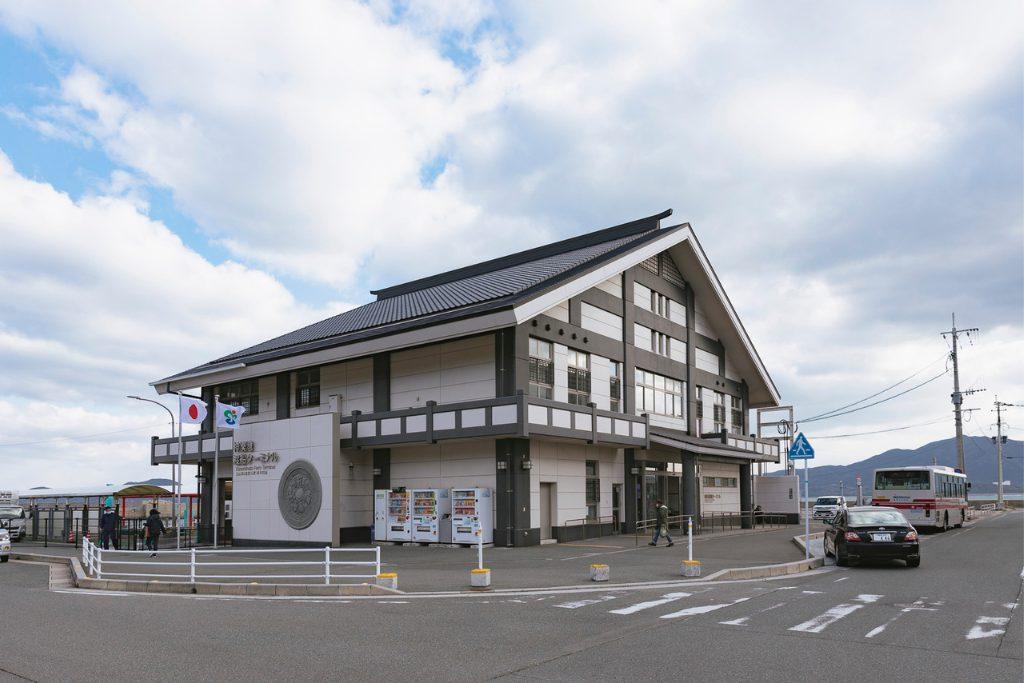
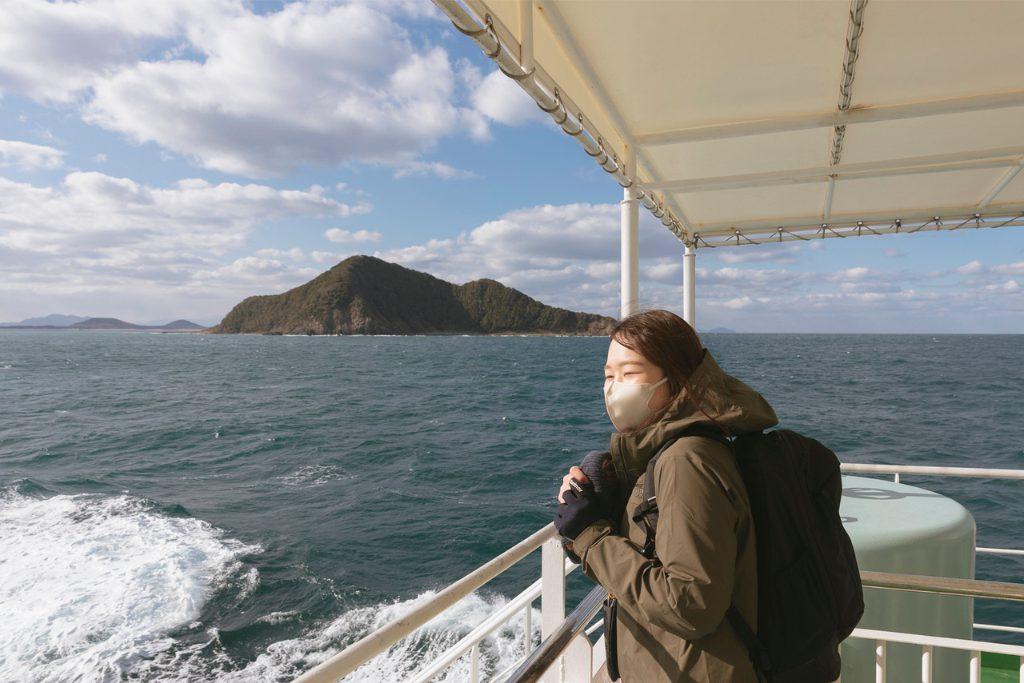
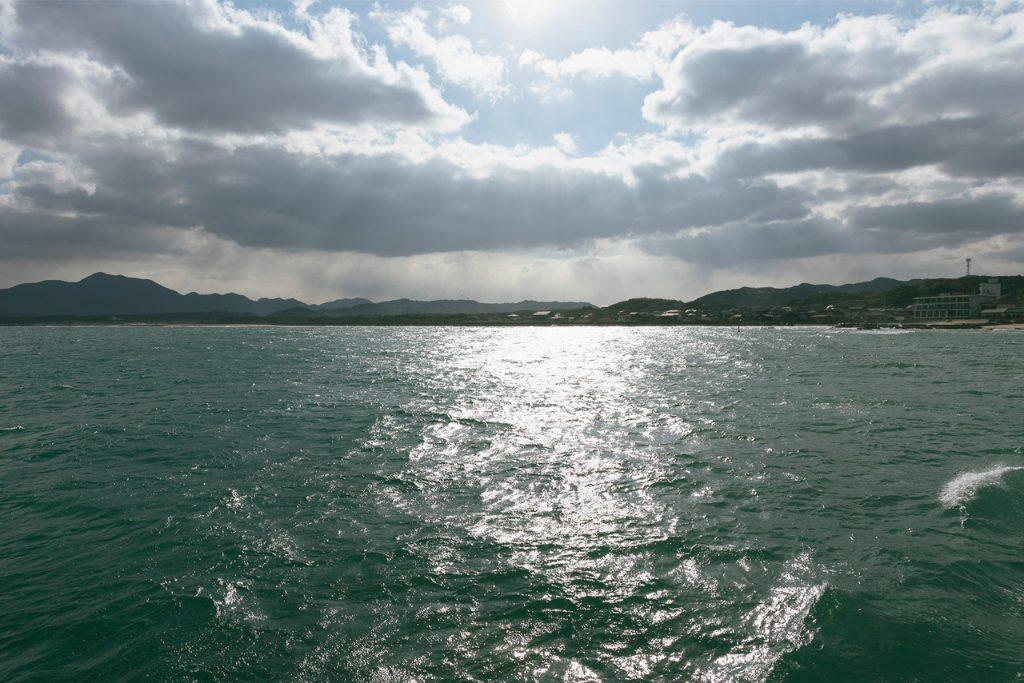
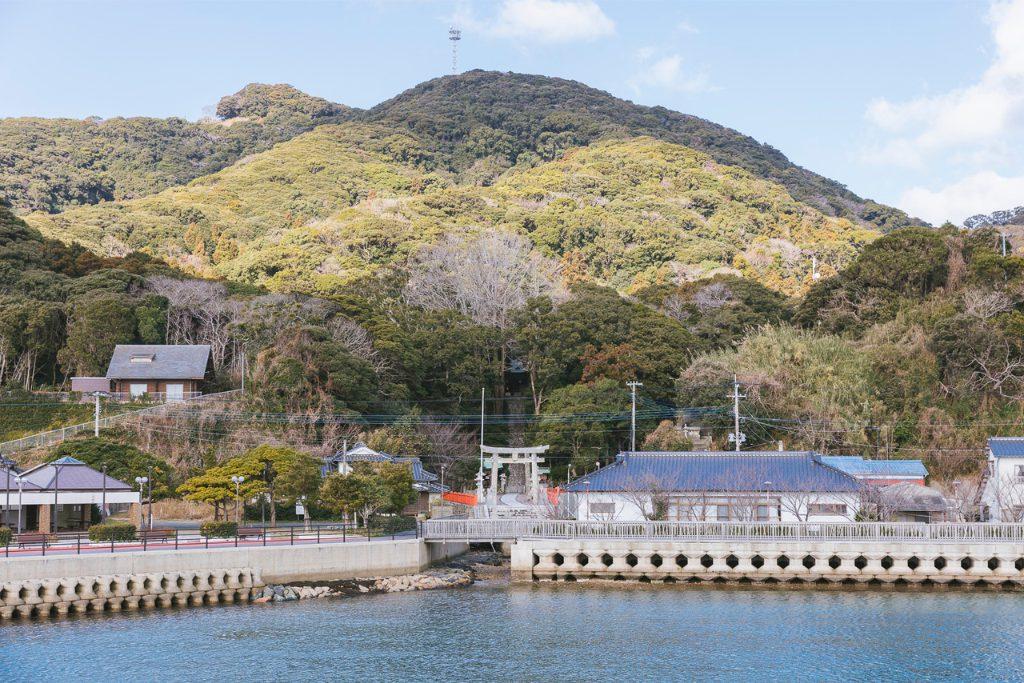
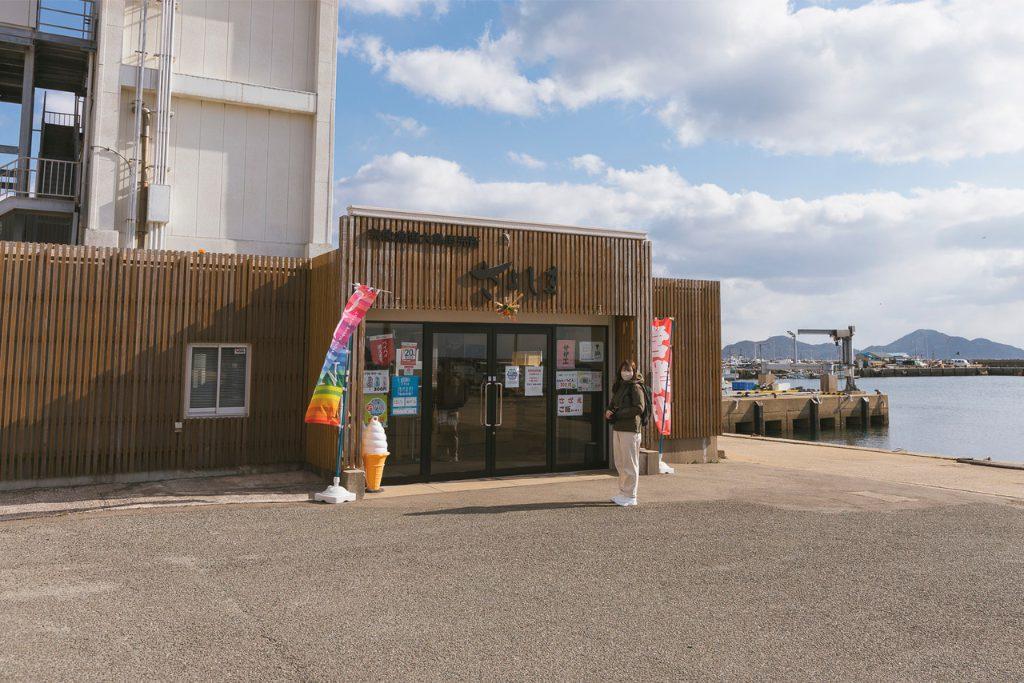
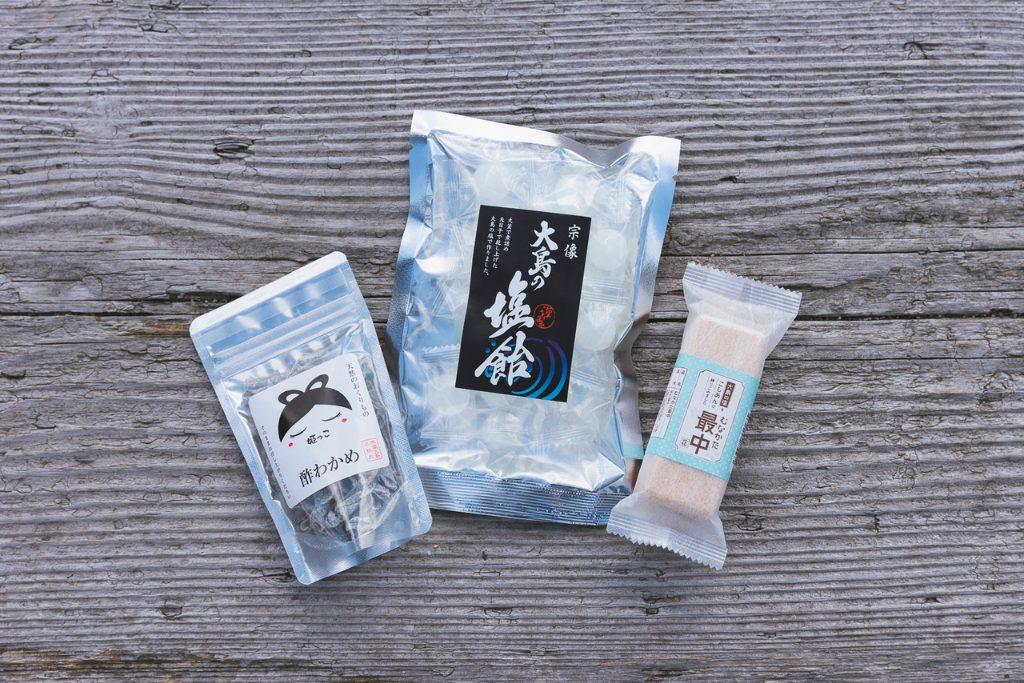
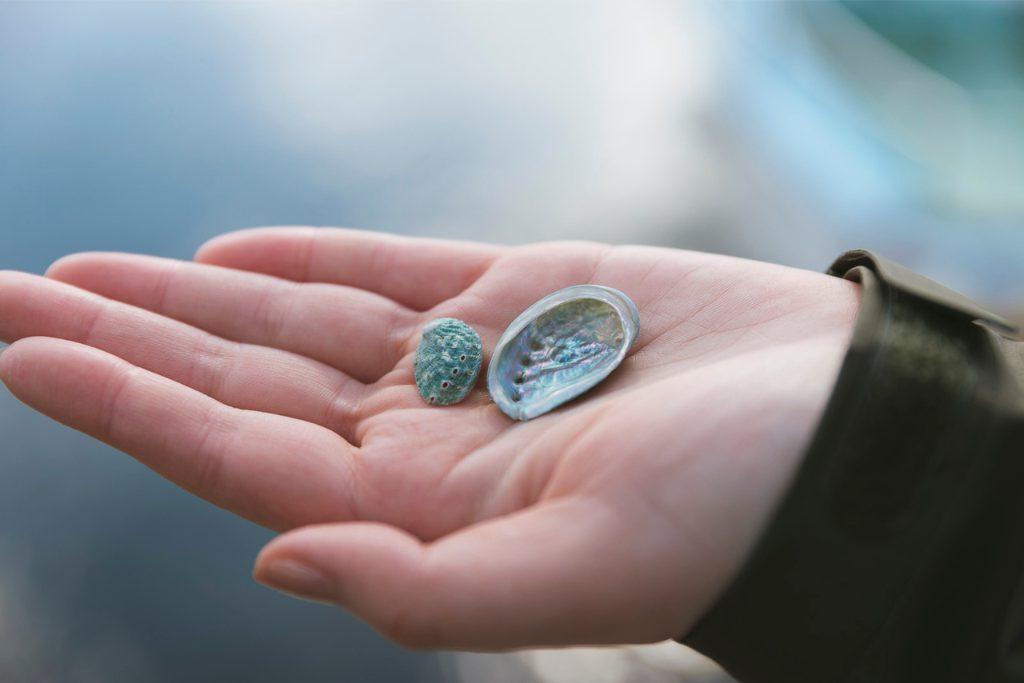
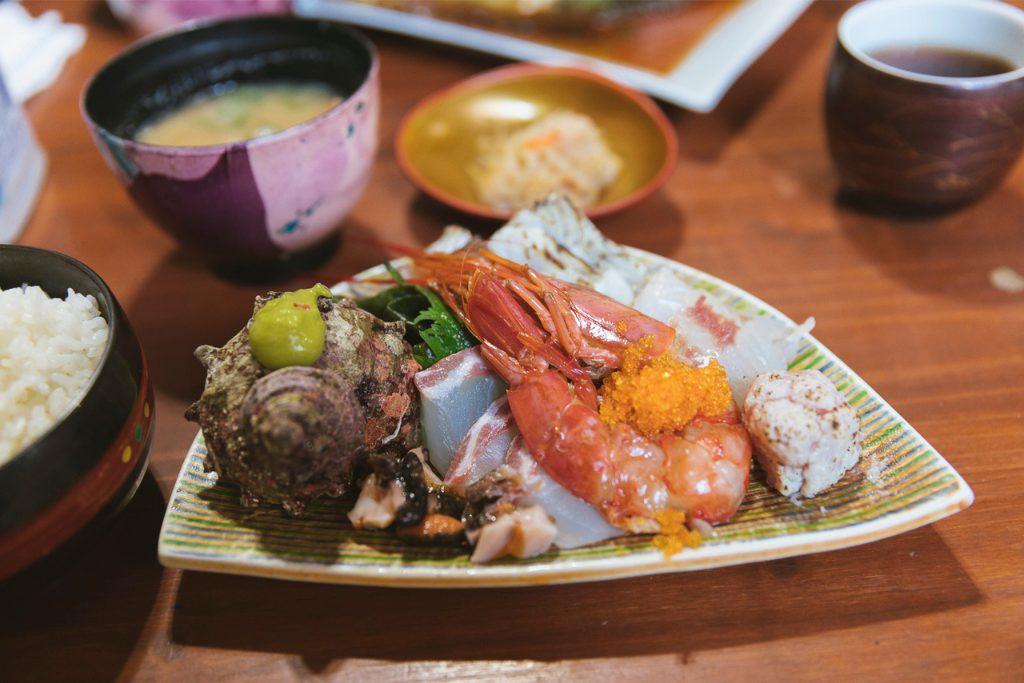
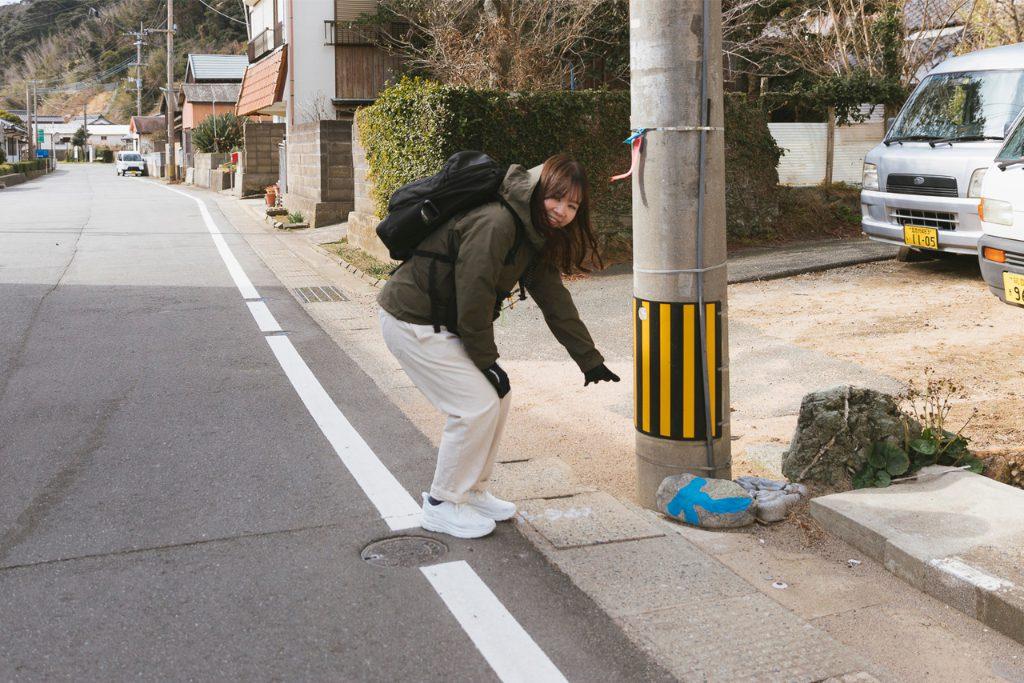
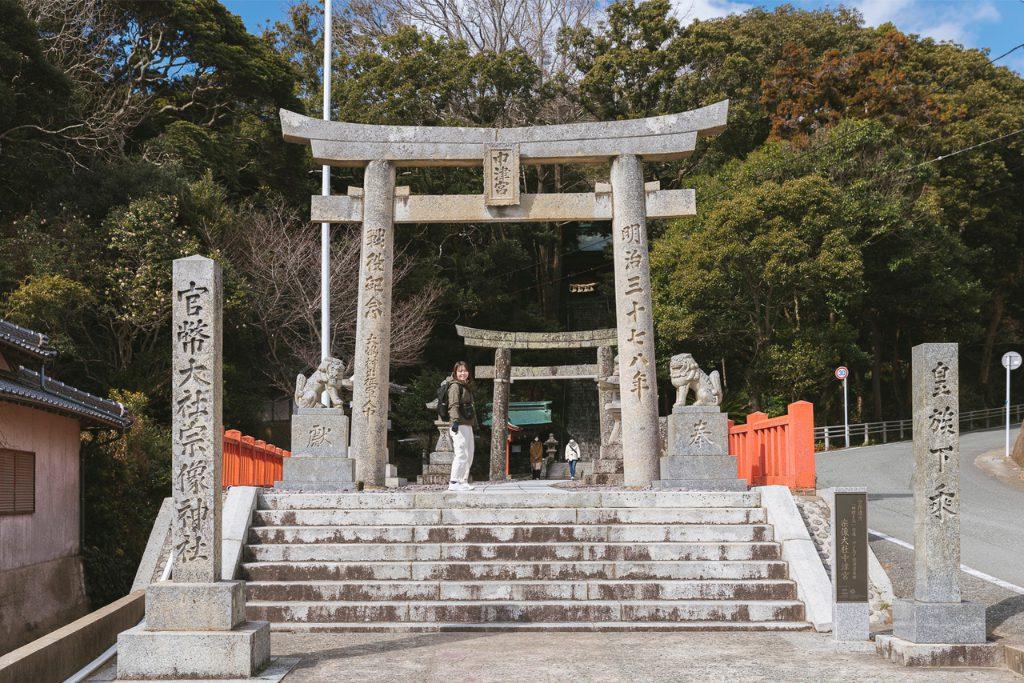
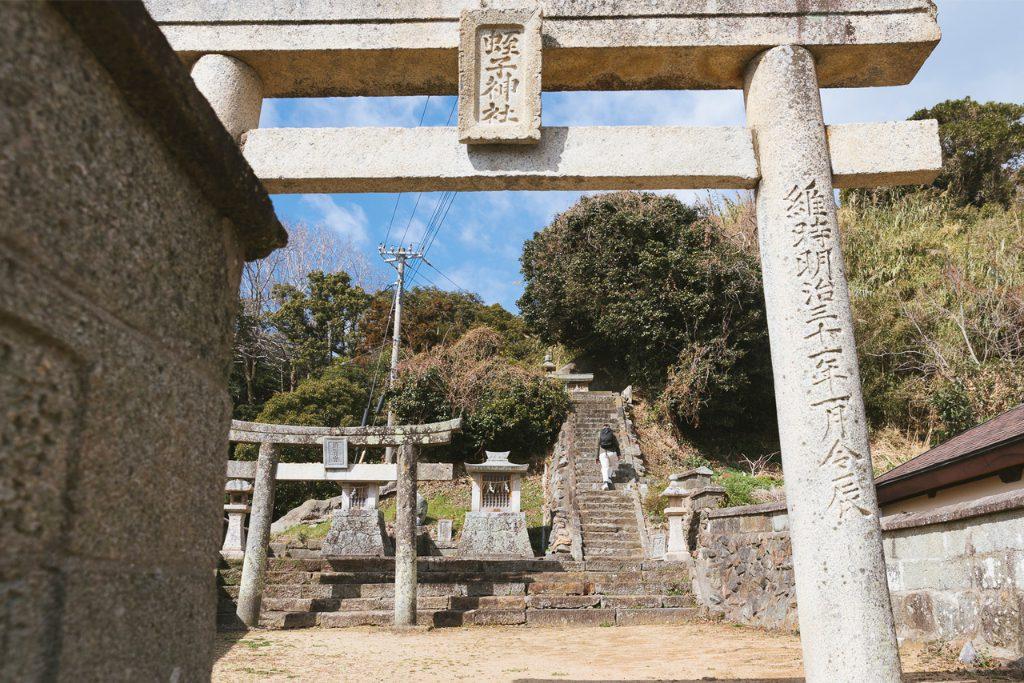
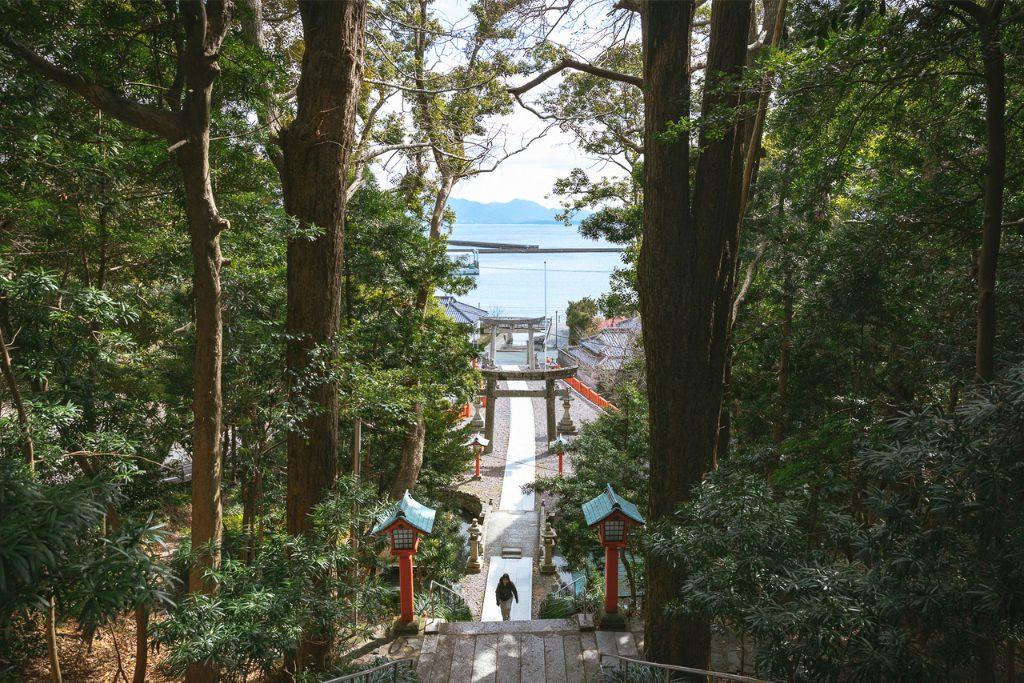
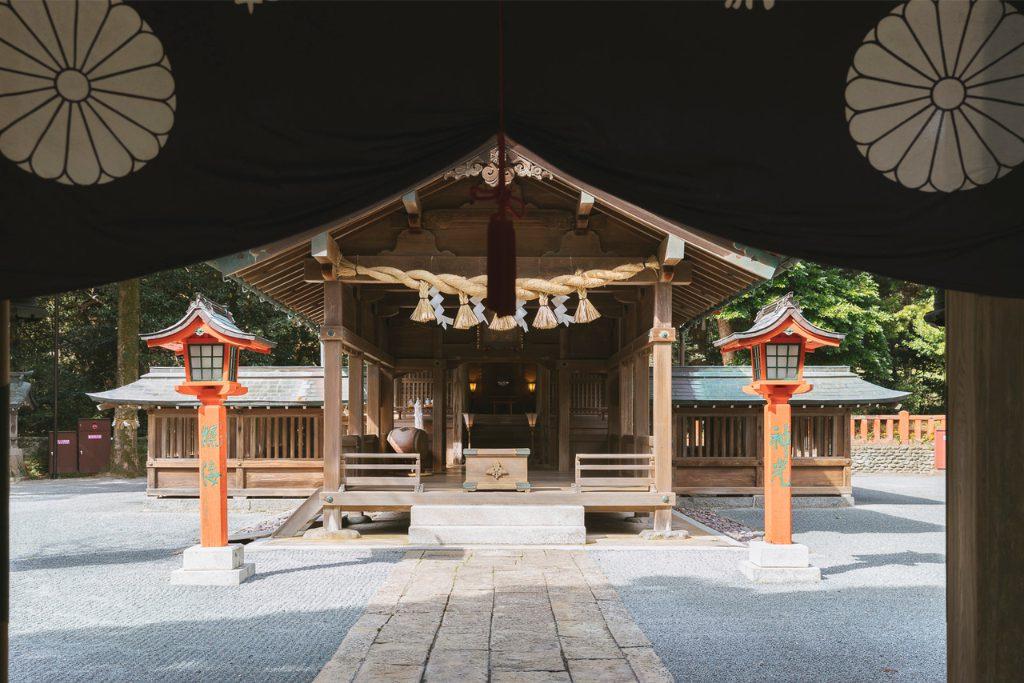
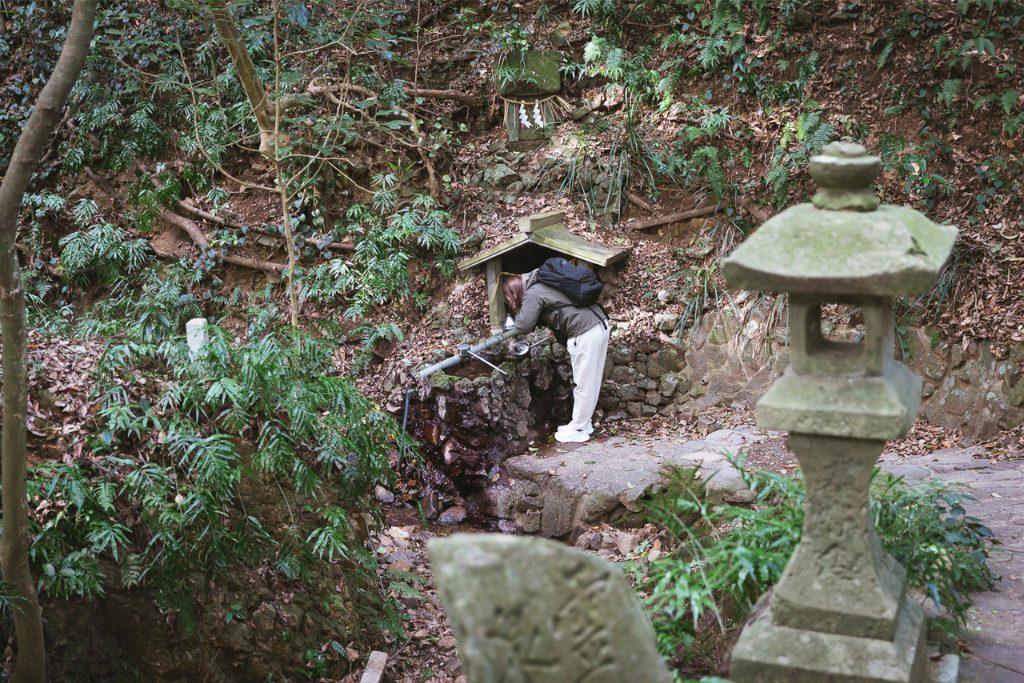
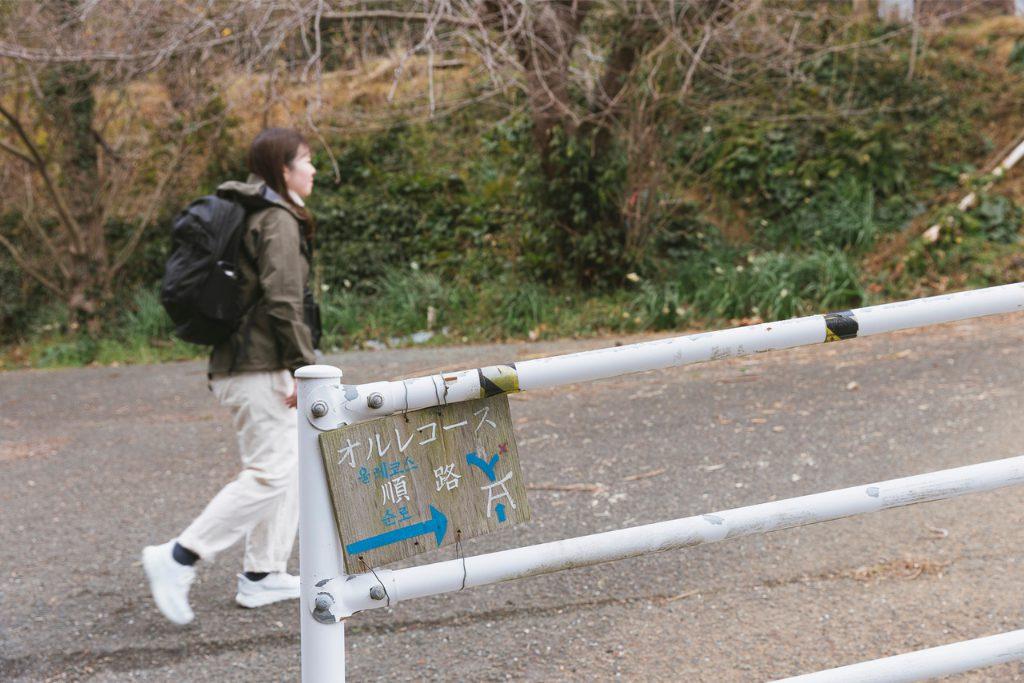
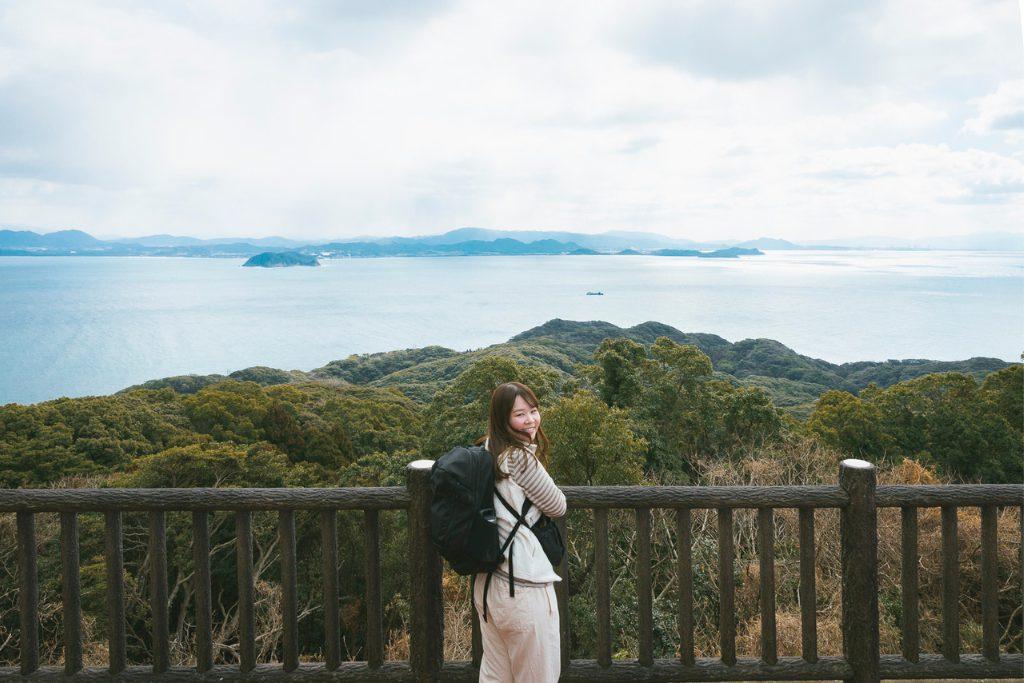
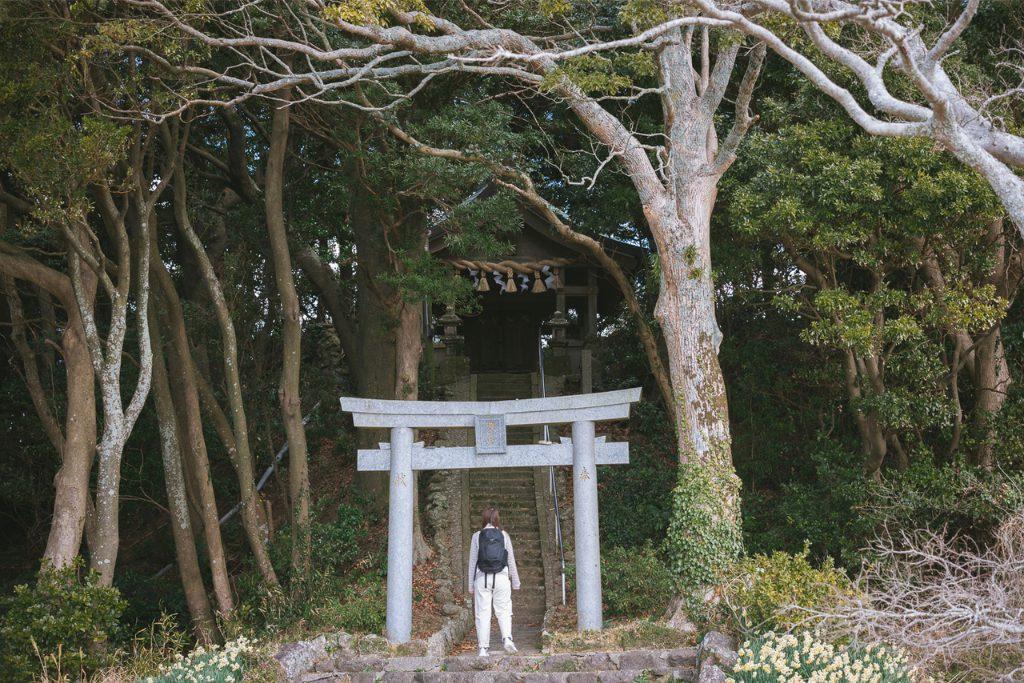
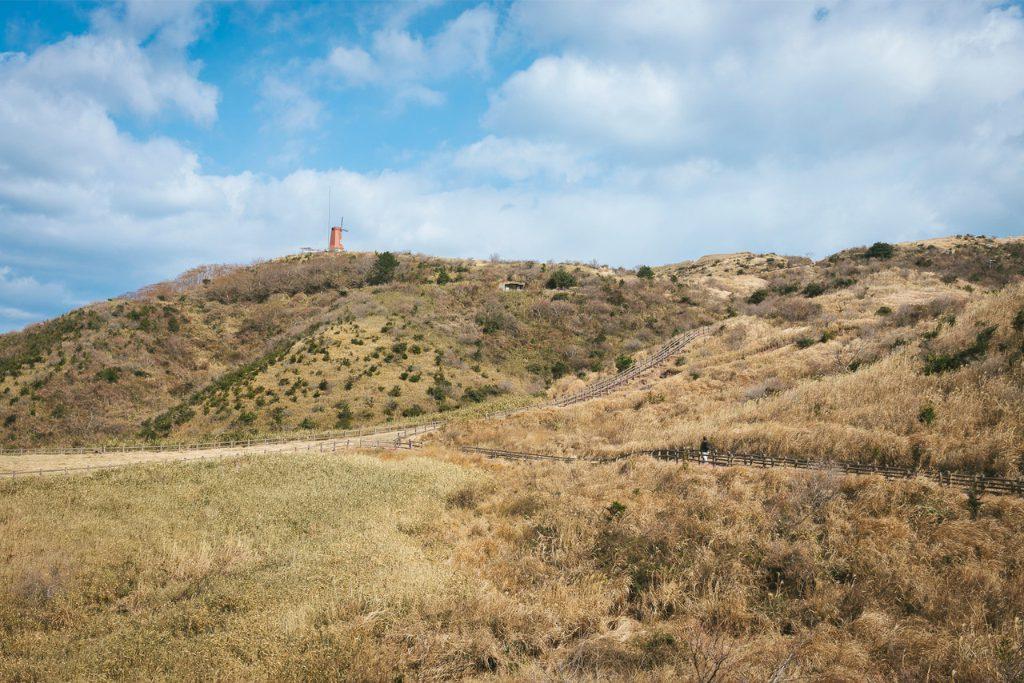
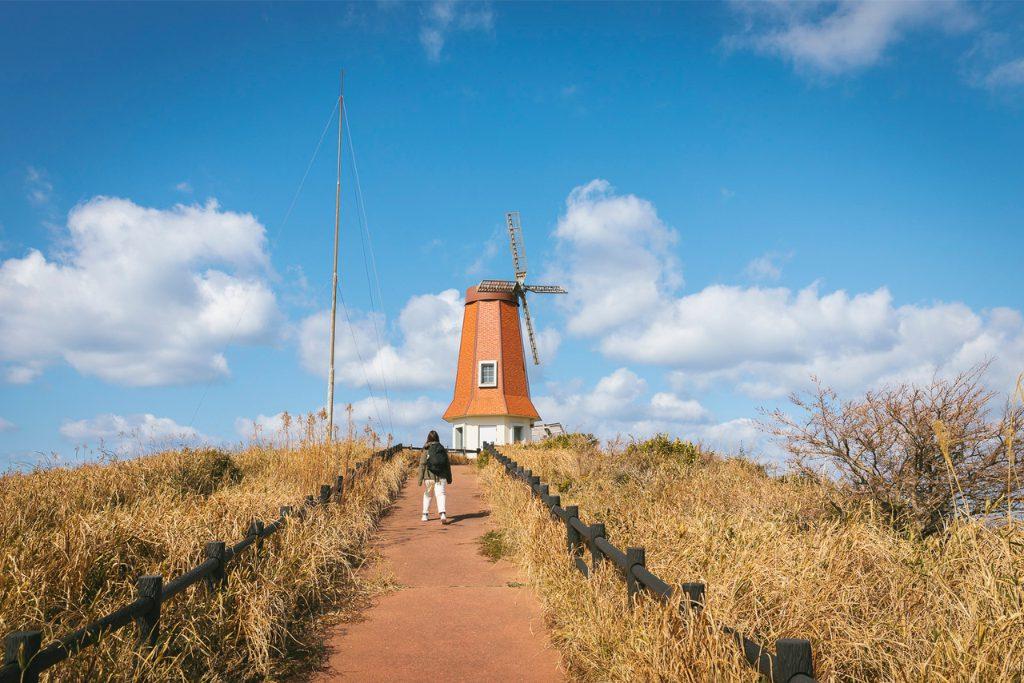
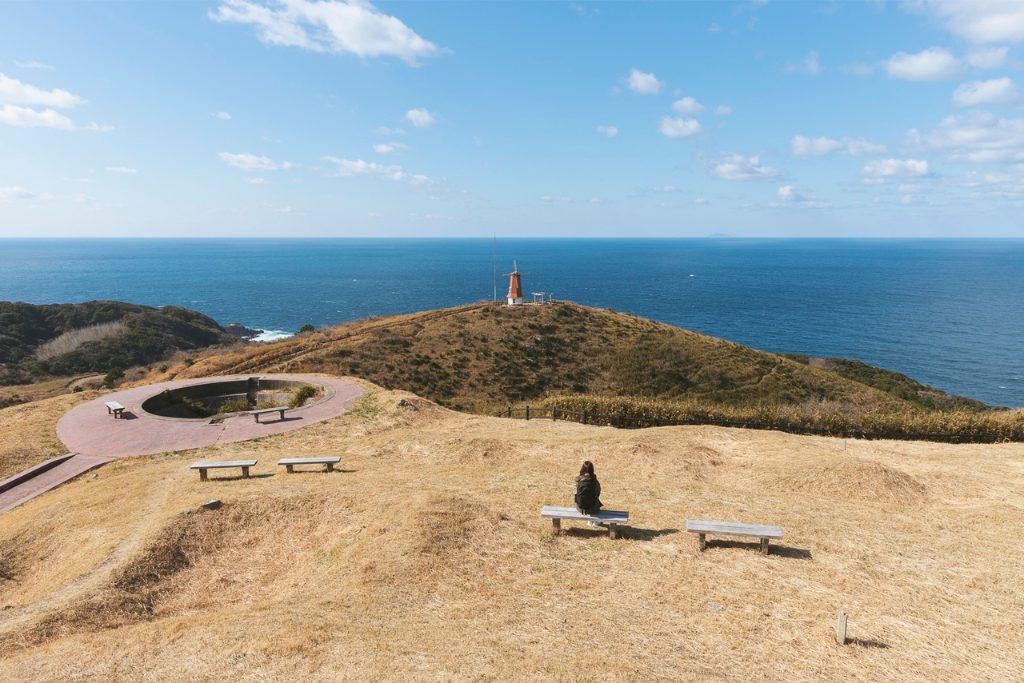
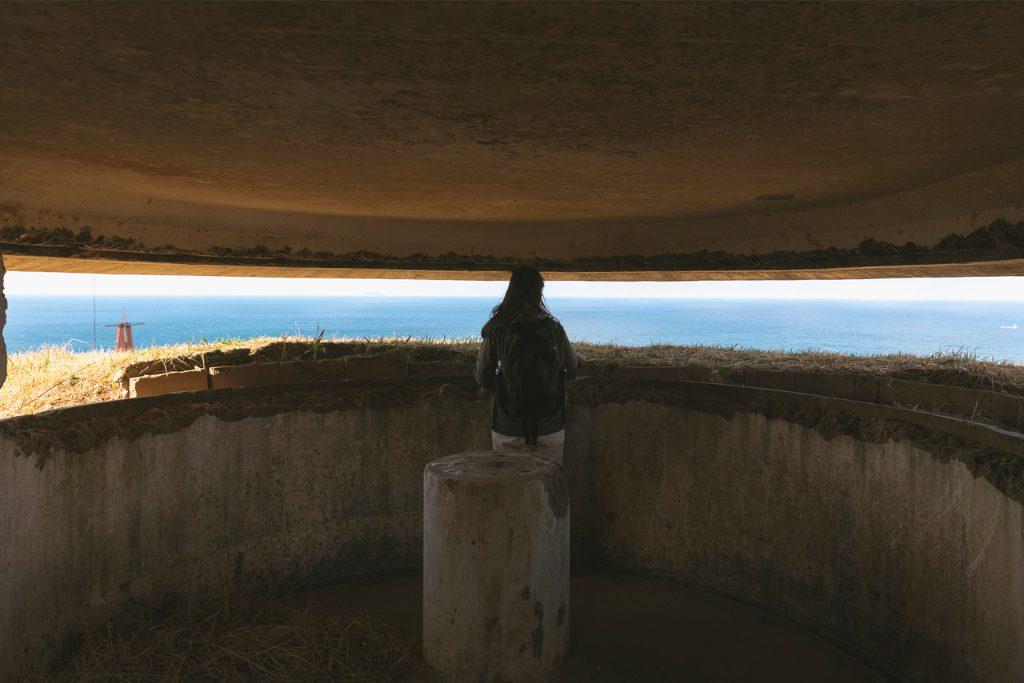
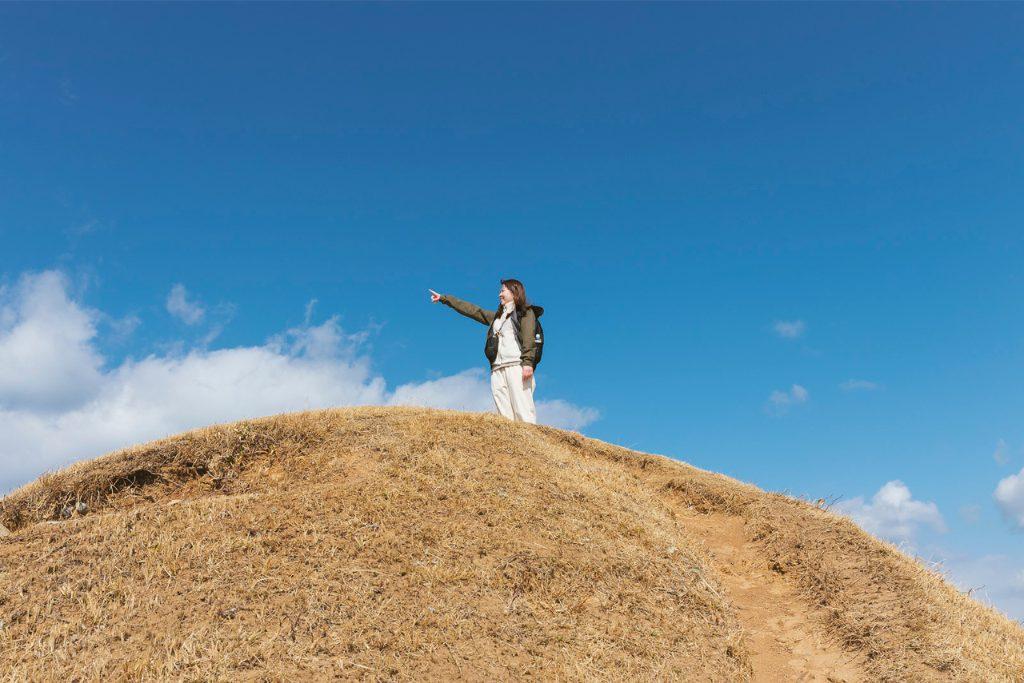
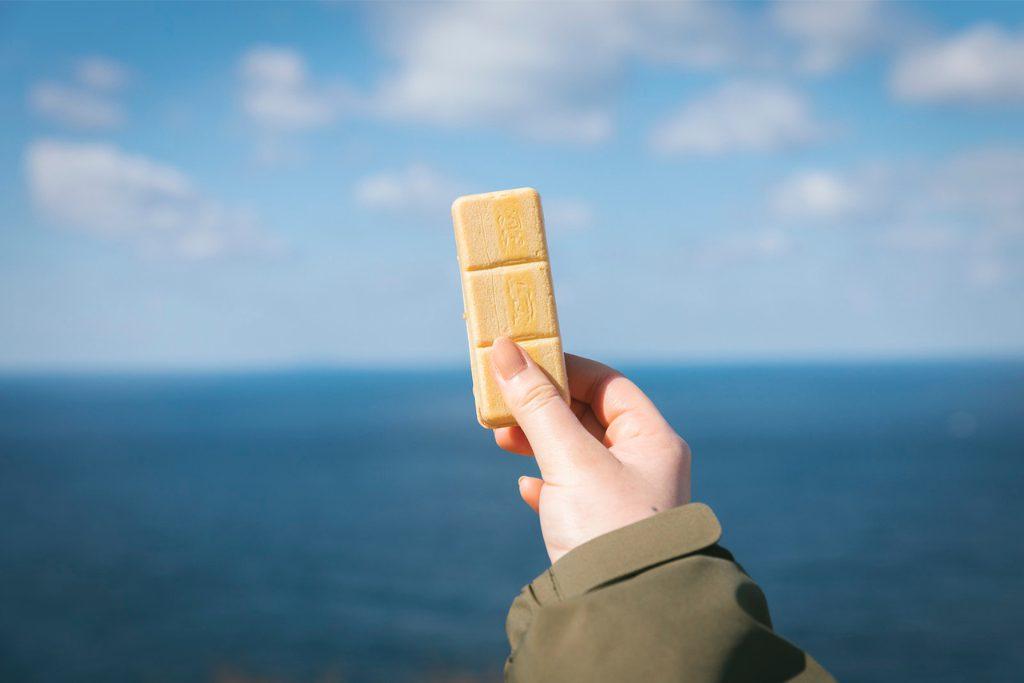
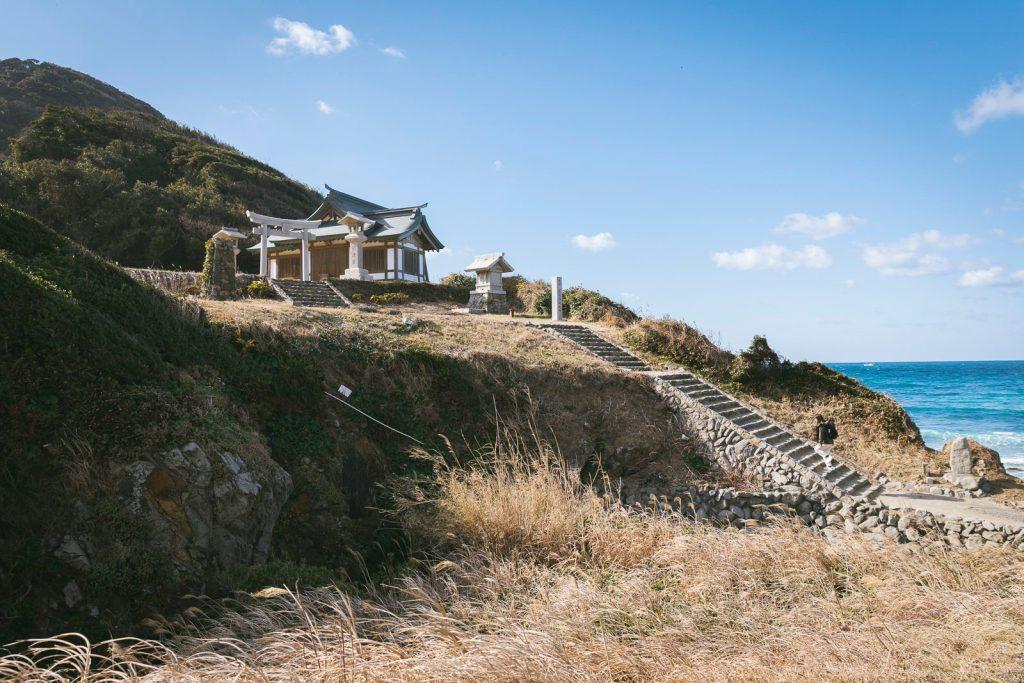
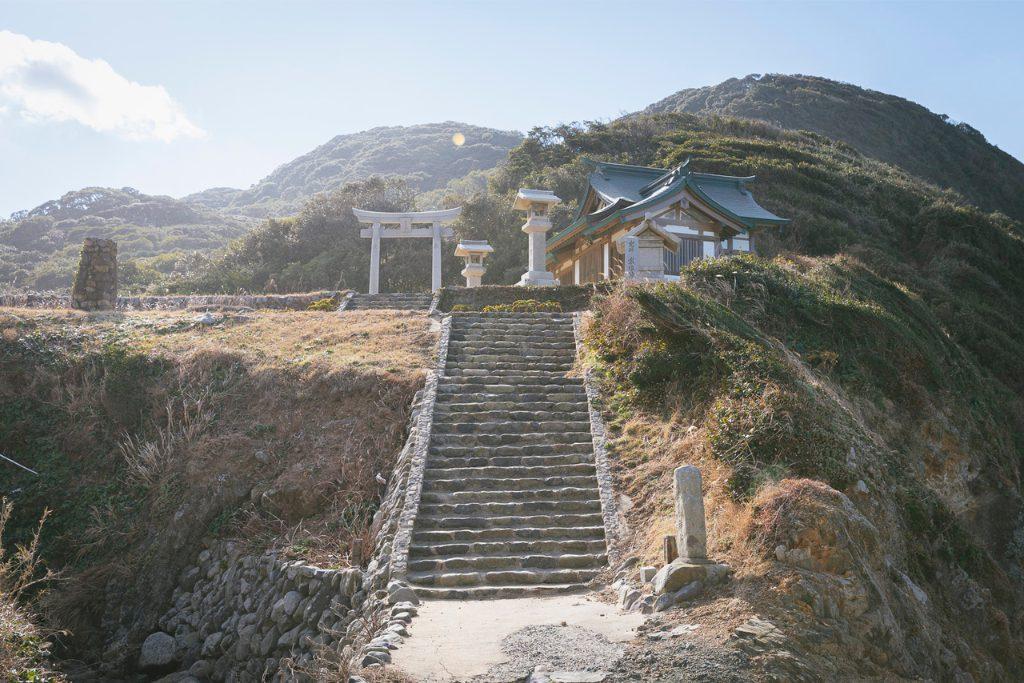
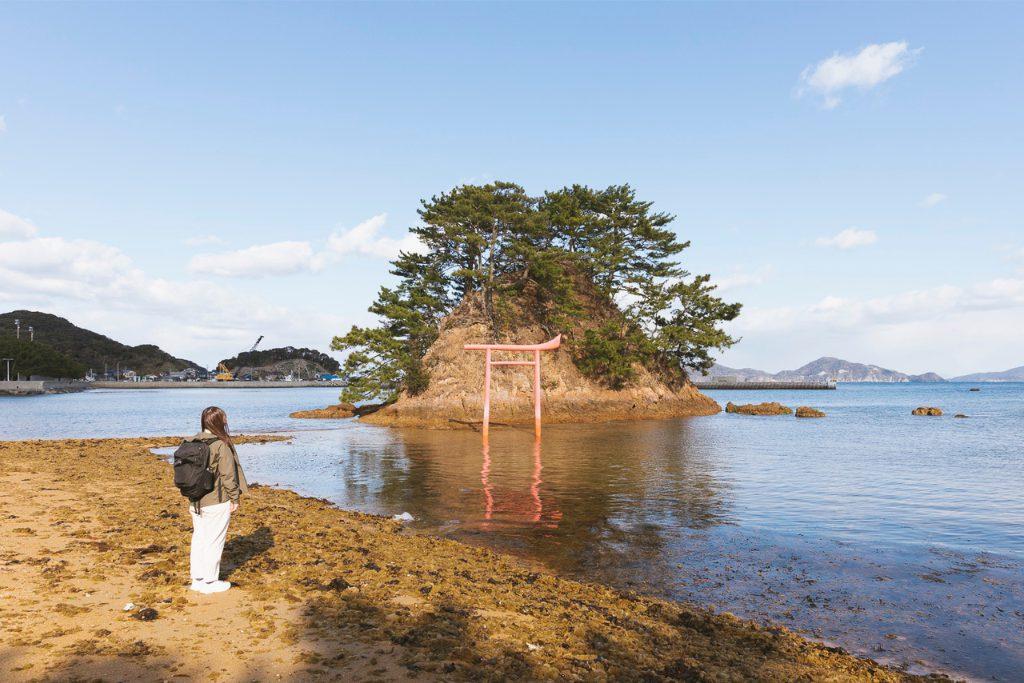
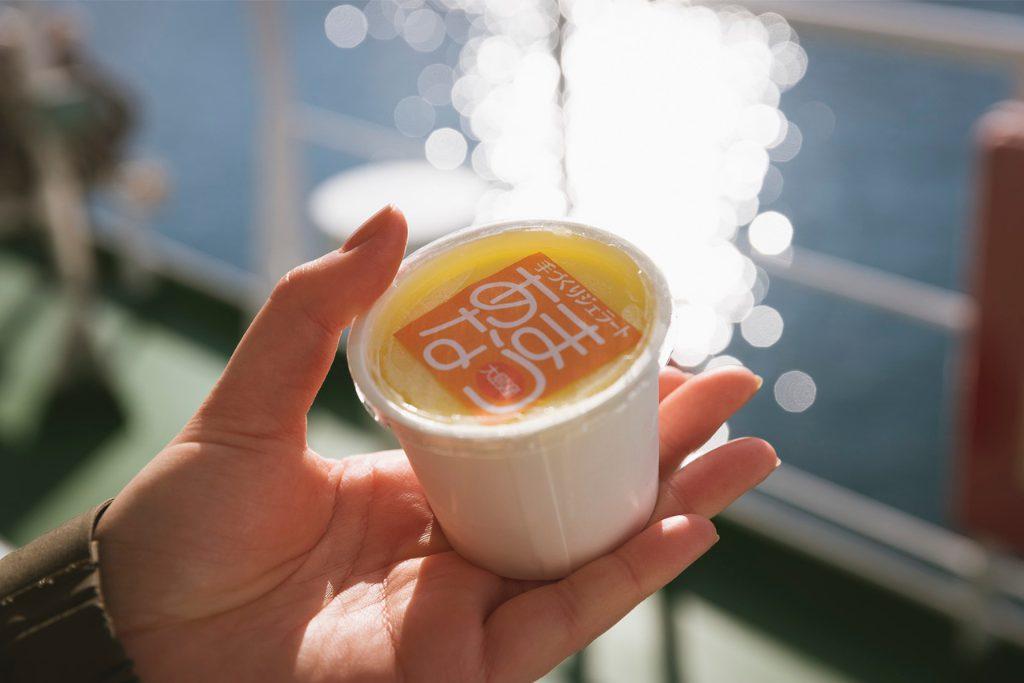
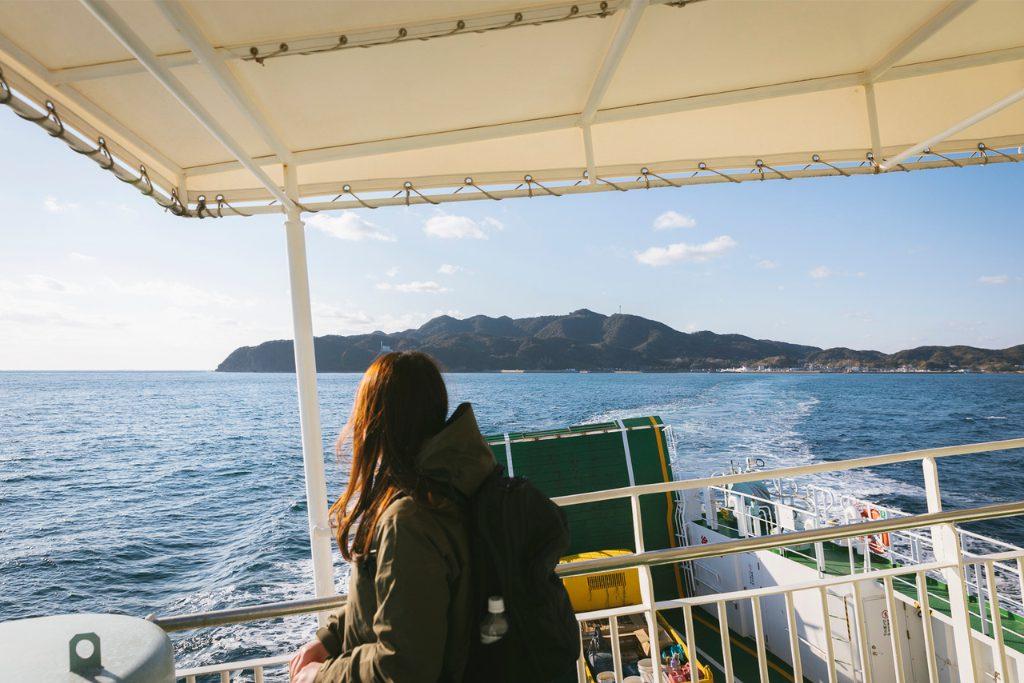
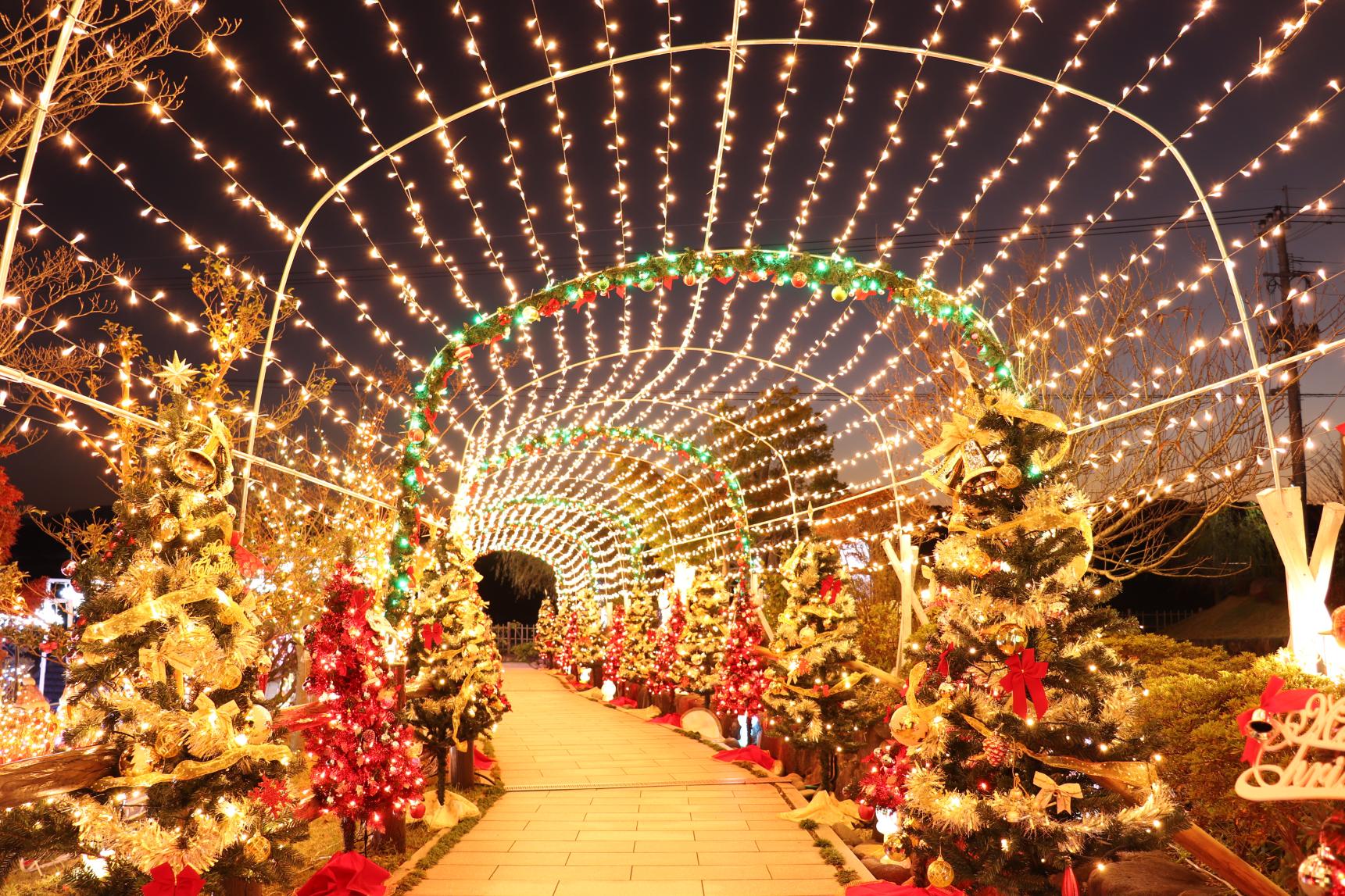
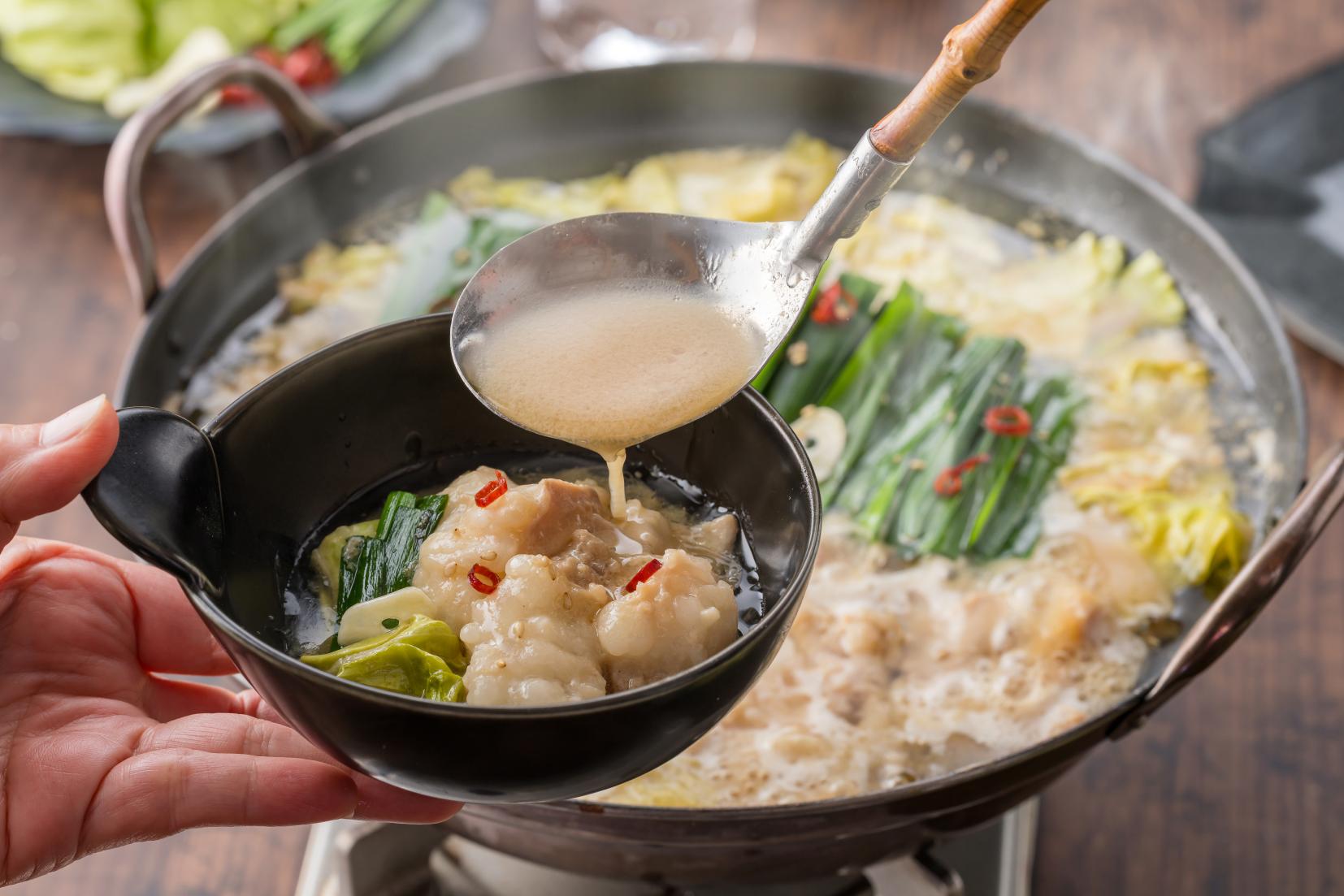
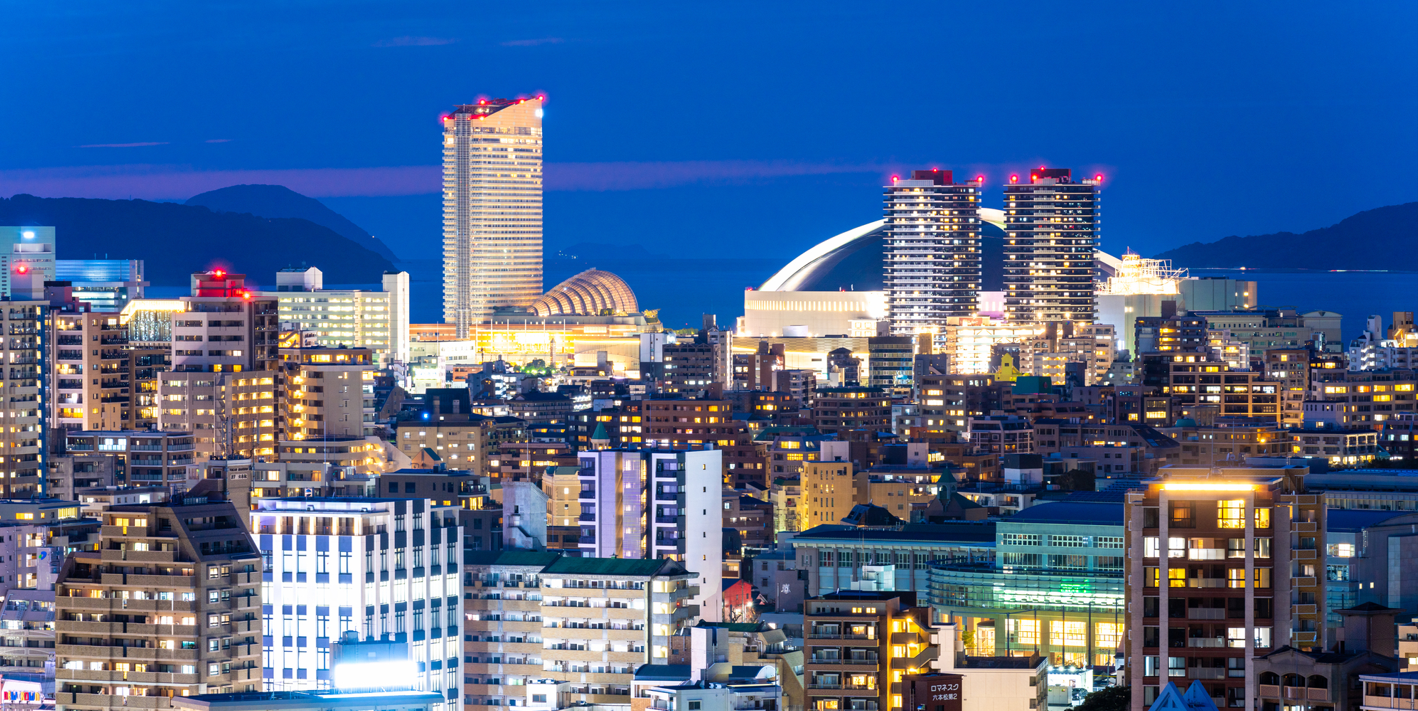
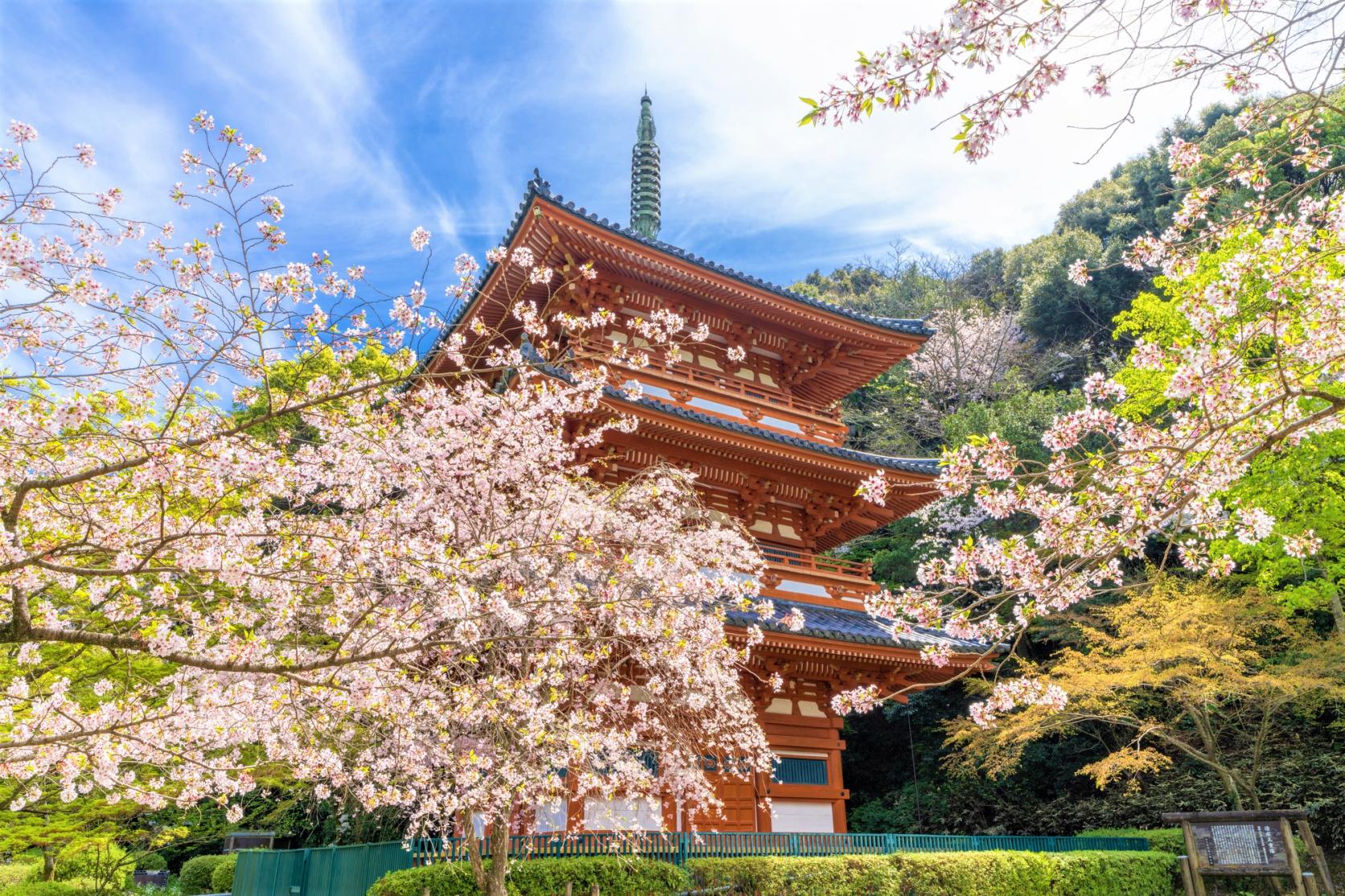
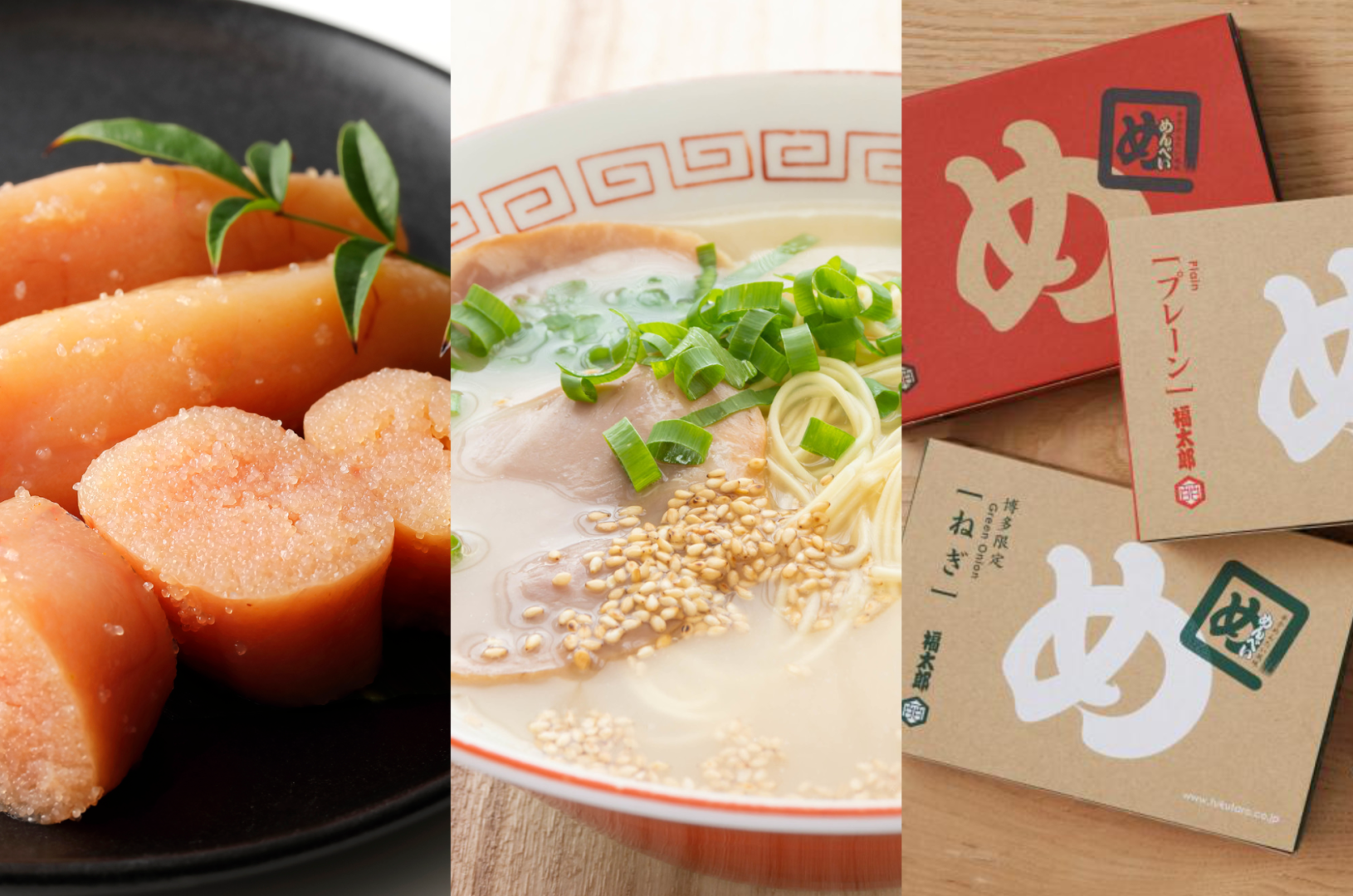
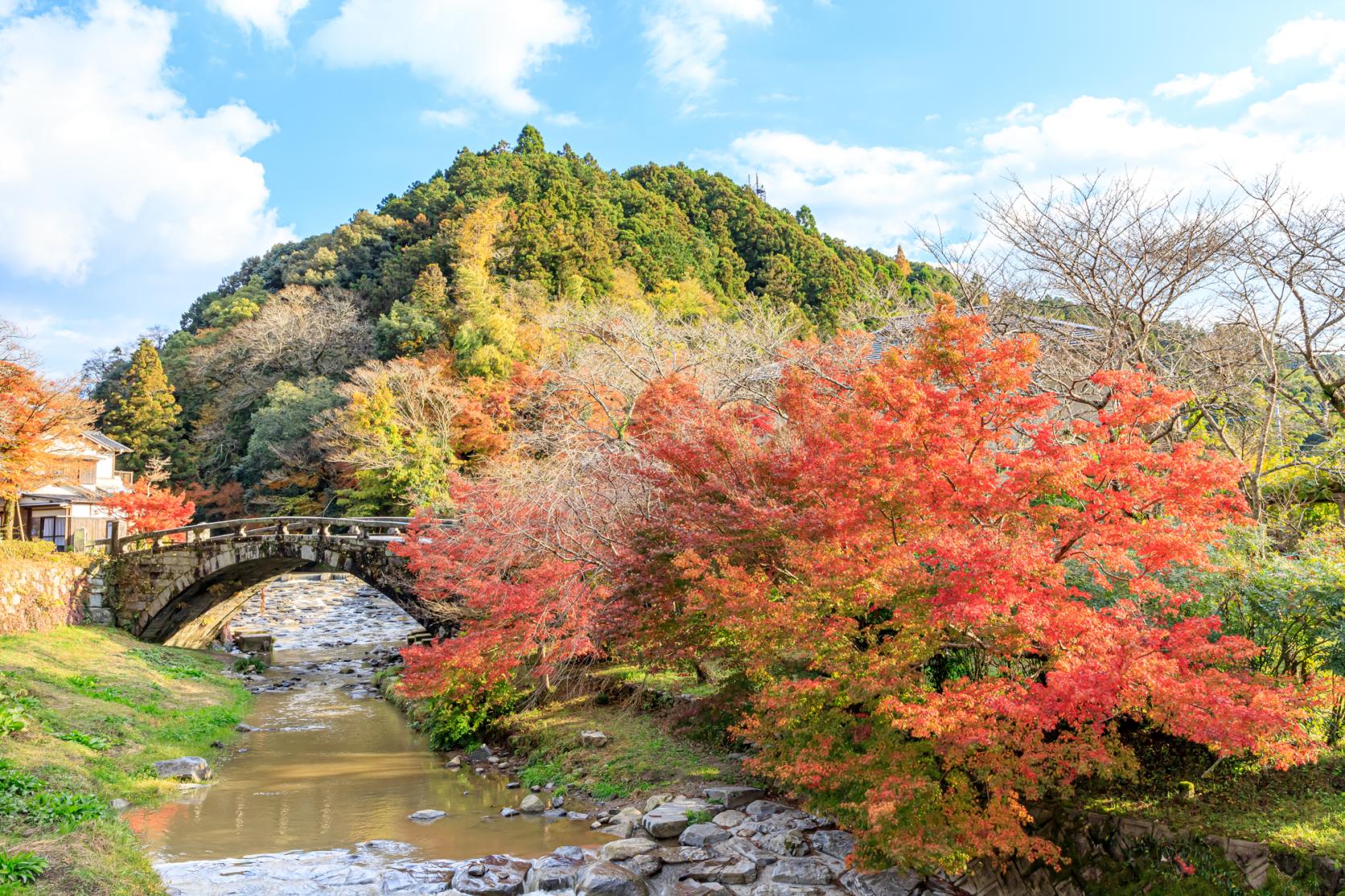

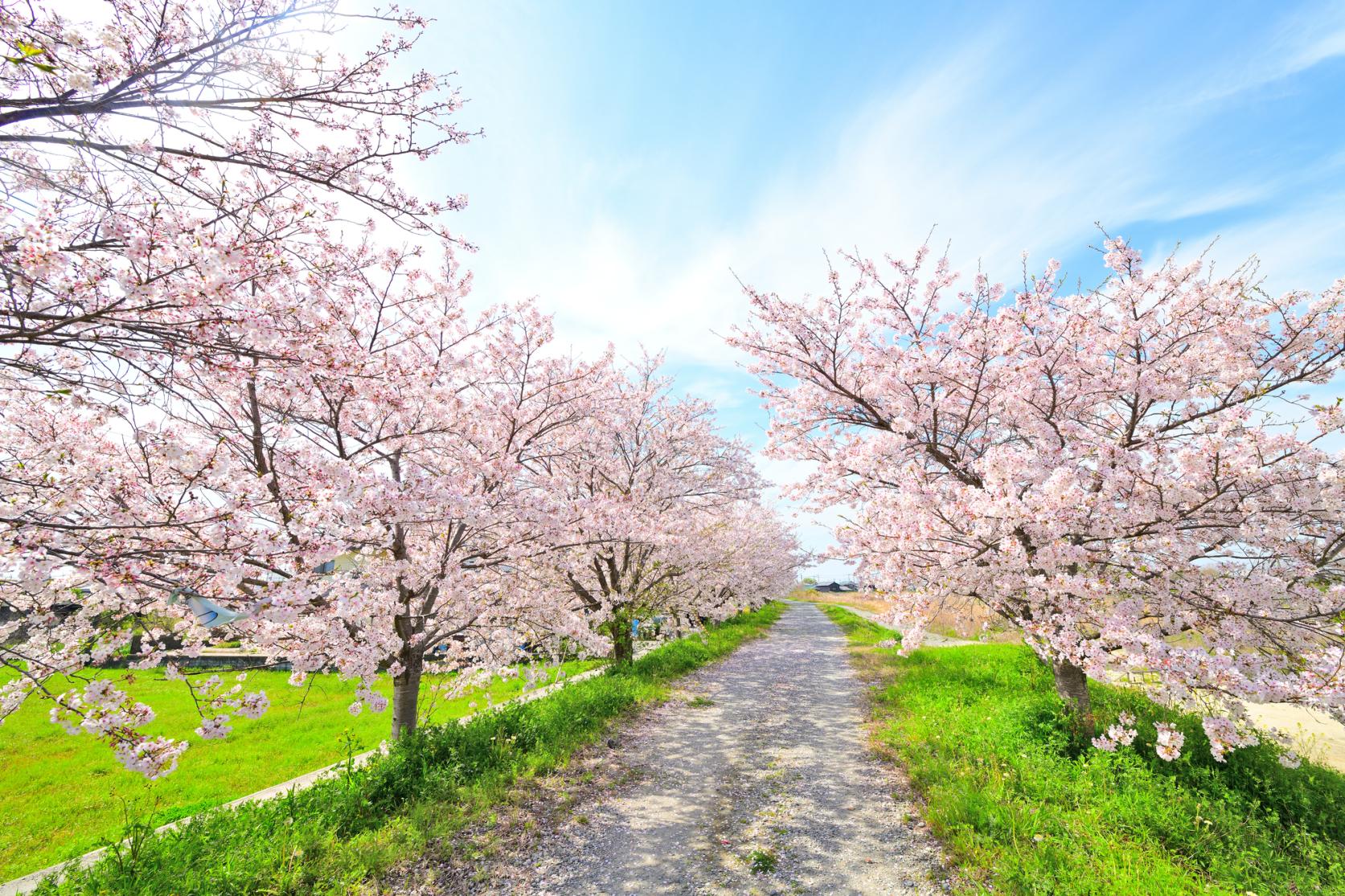
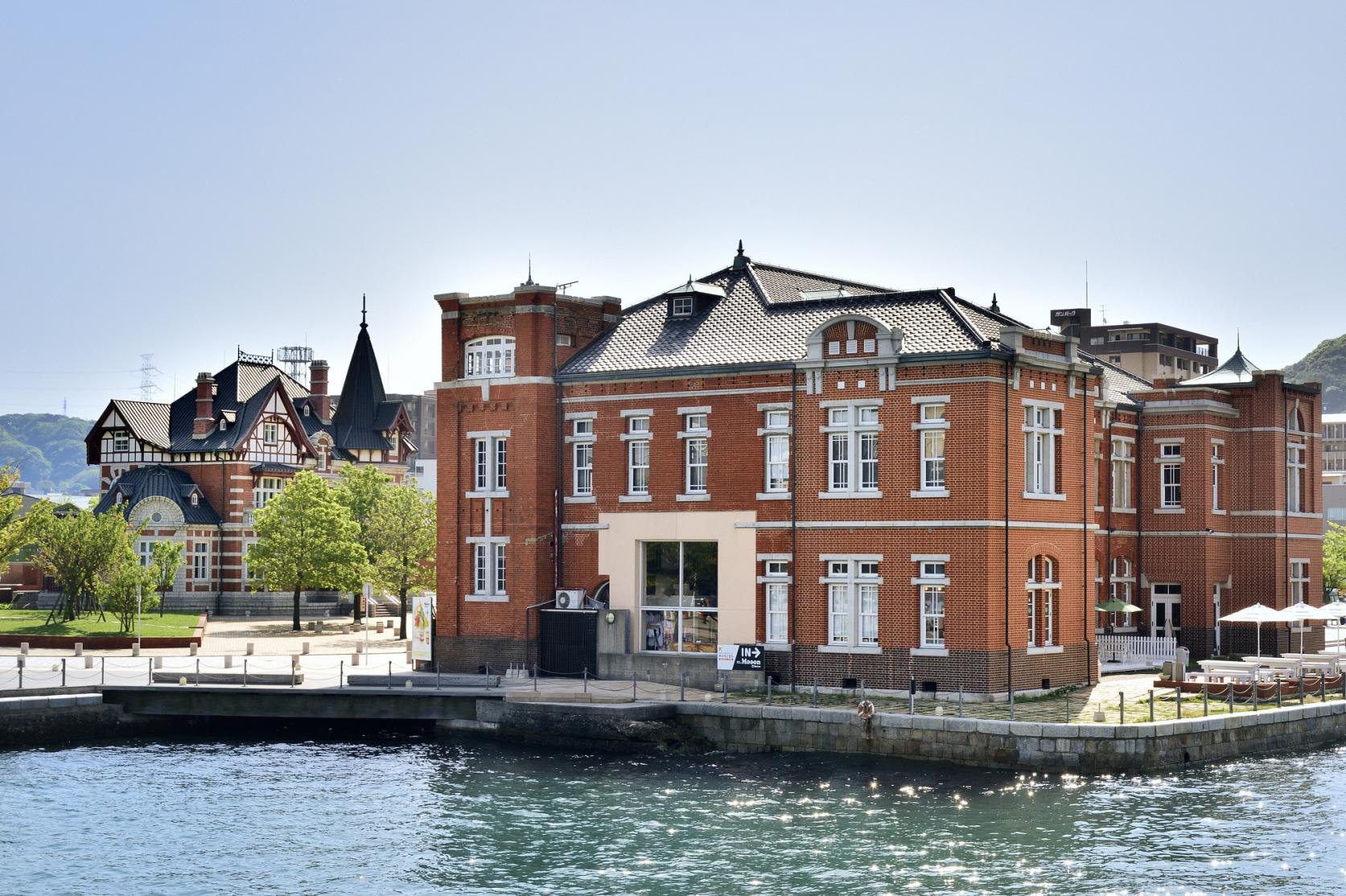
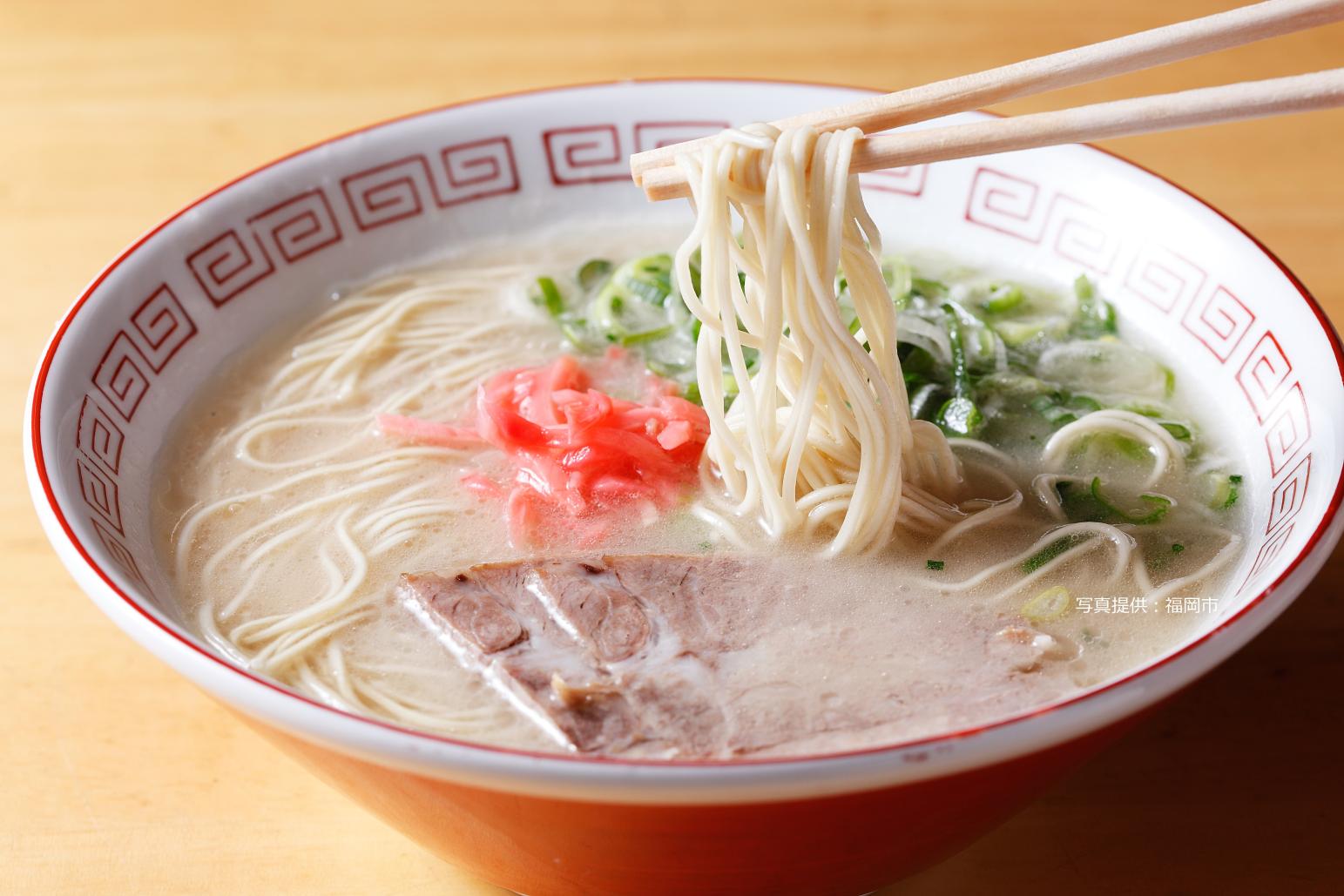
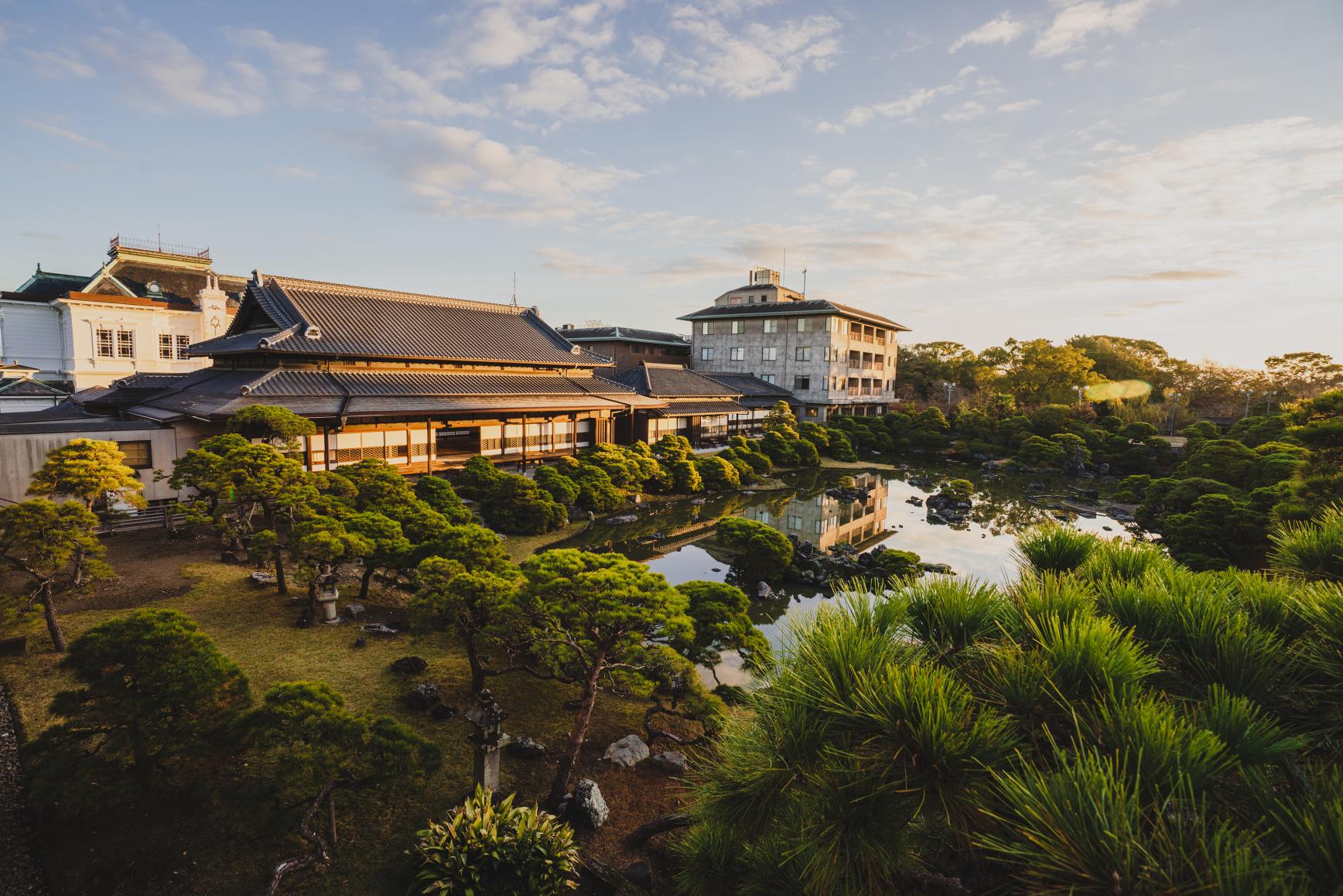
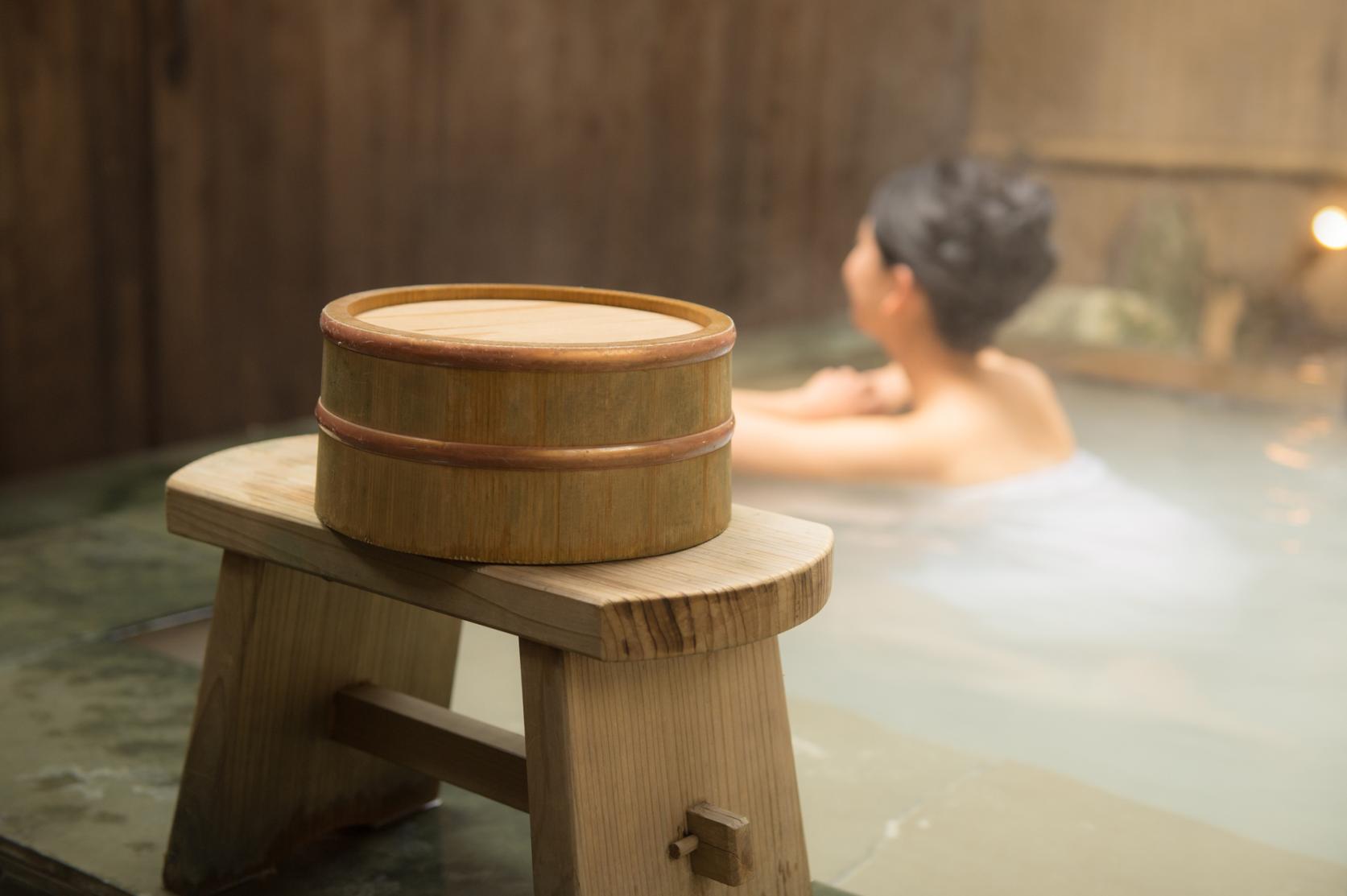
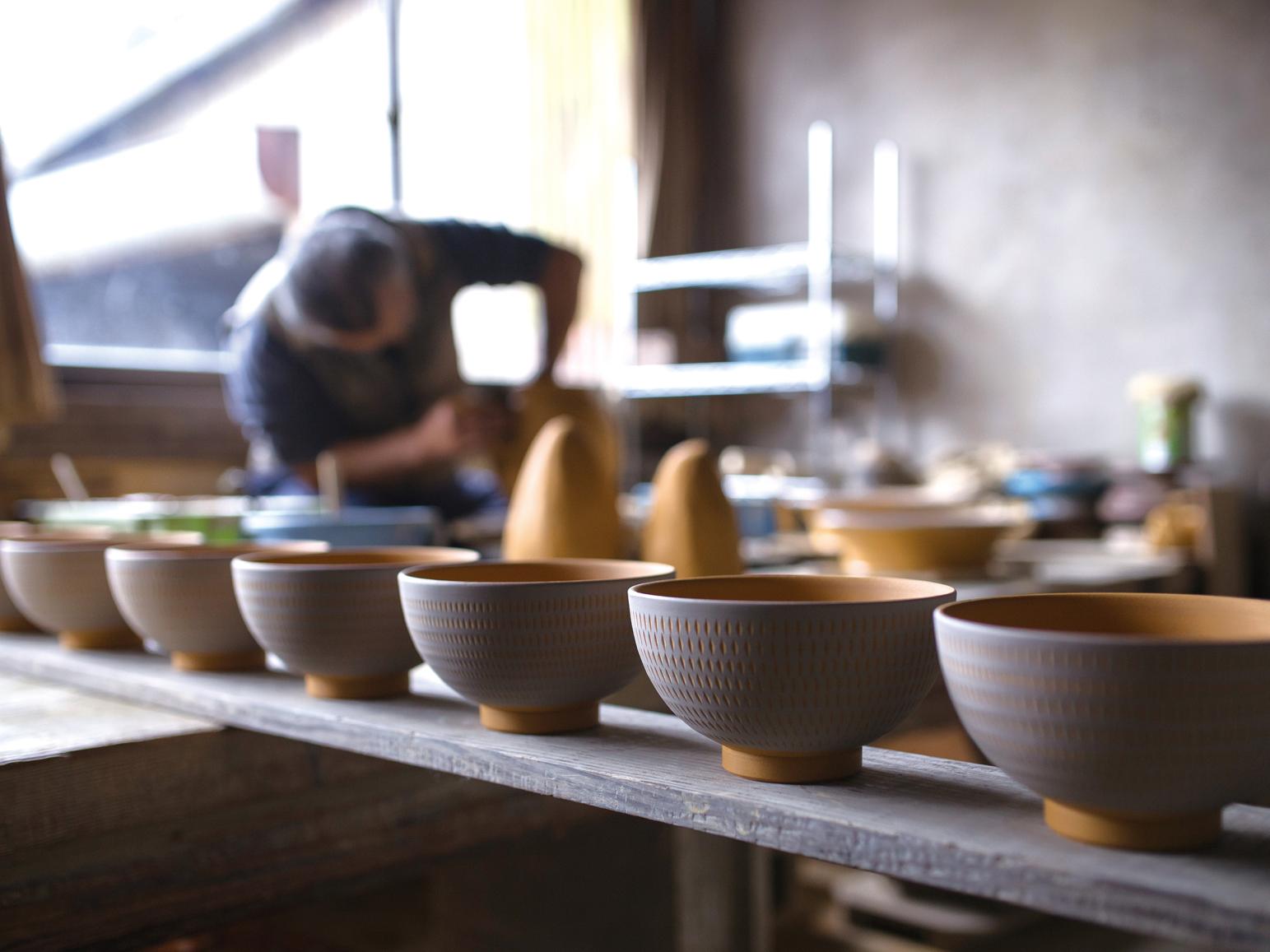
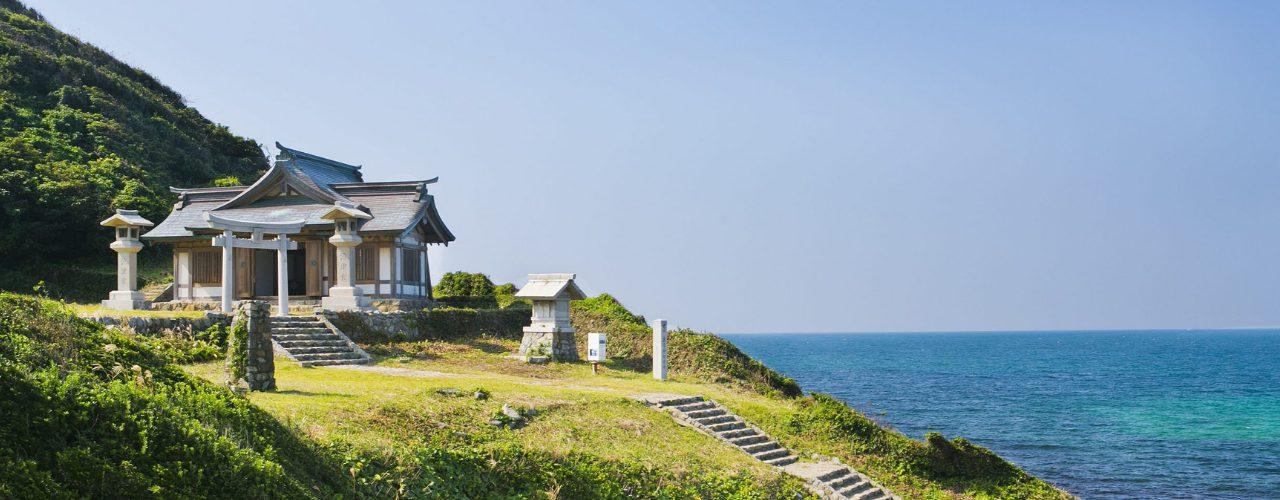
![[2025] Strawberry Picking Spots in Fukuoka-1](https://www.crossroadfukuoka.jp/storage/special_features/49/responsive_images/9ZHgrqvQdpH8tM4IRF54DXu0aPBF3YGGkj5WOTGc__1673_1115.jpg)
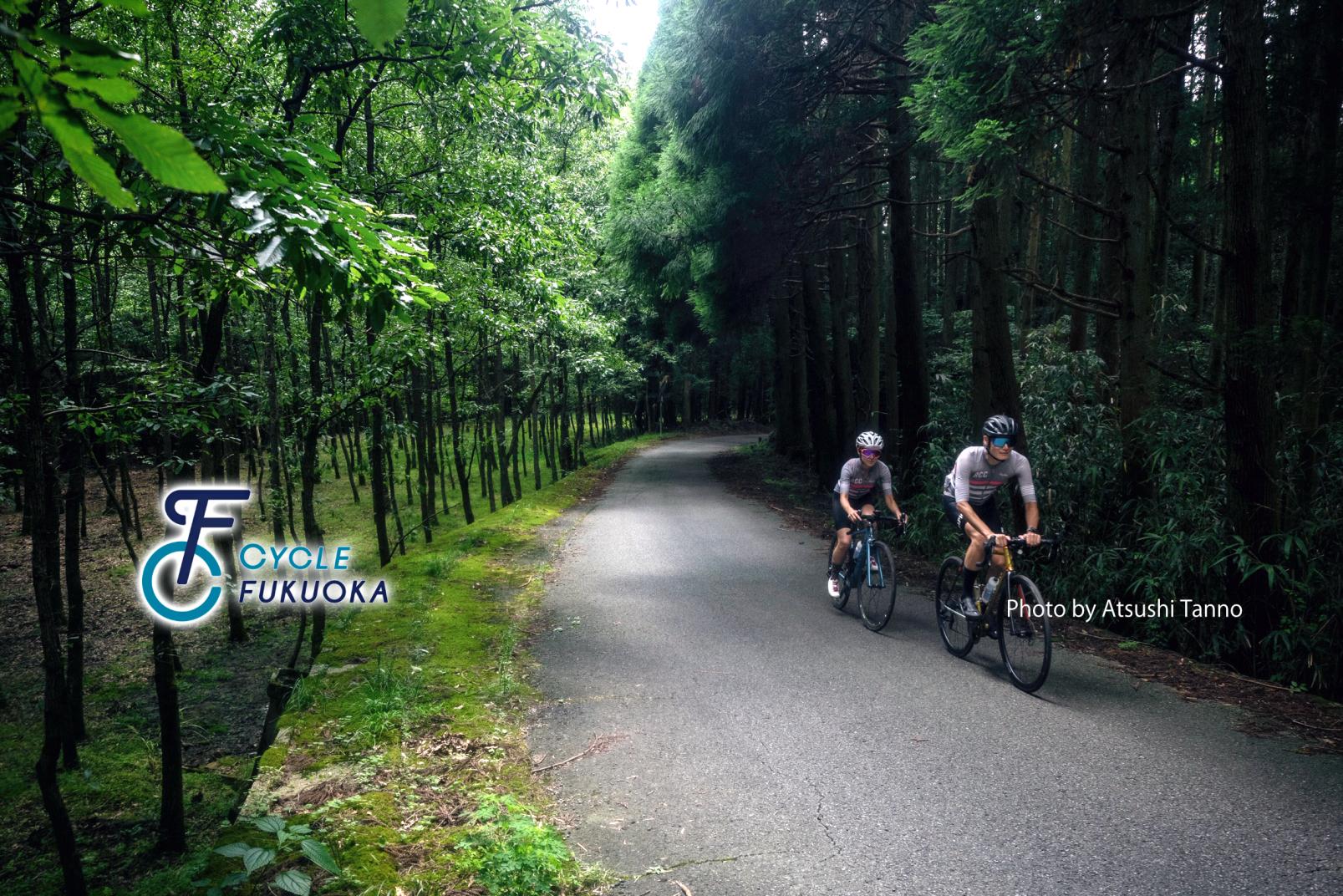
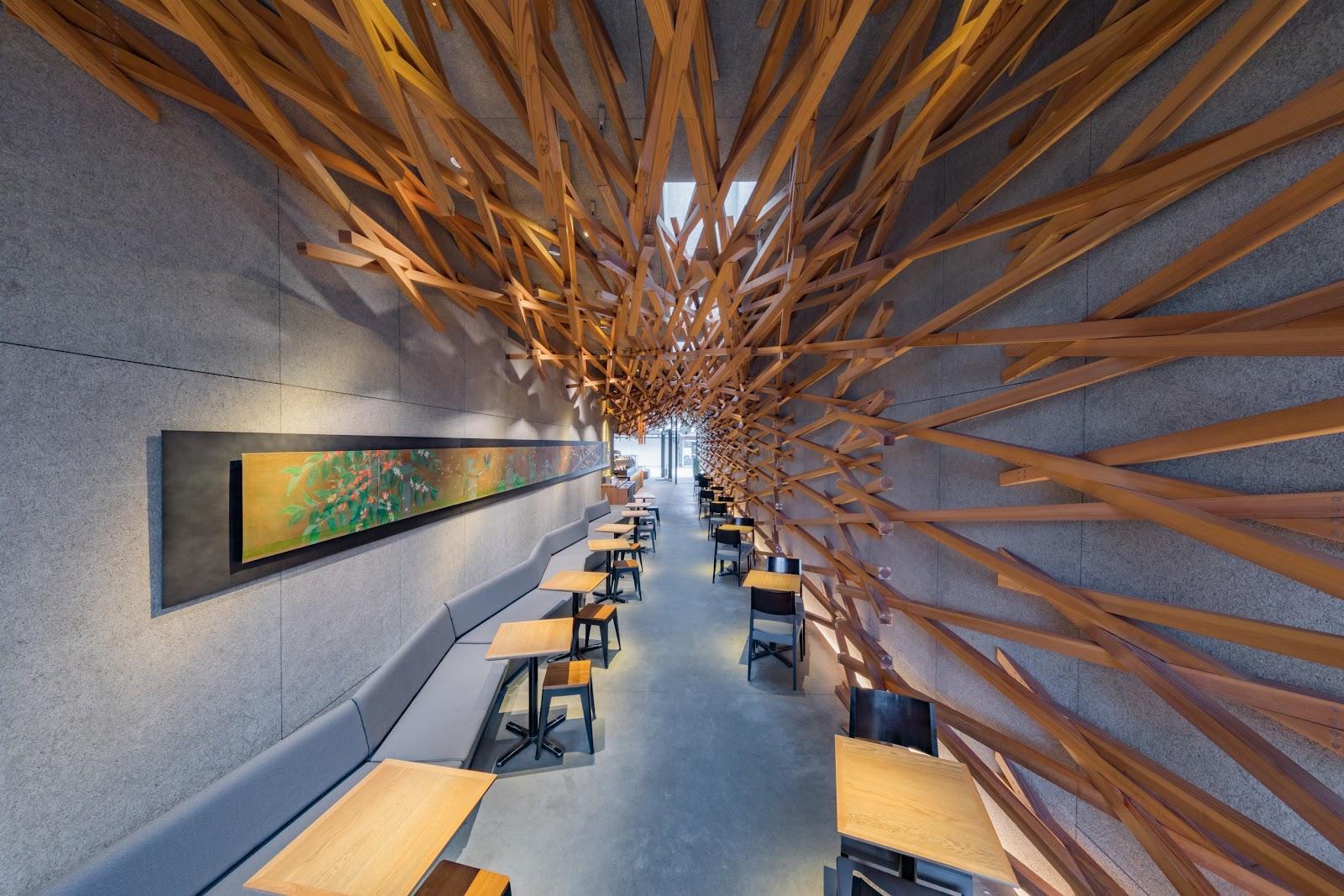
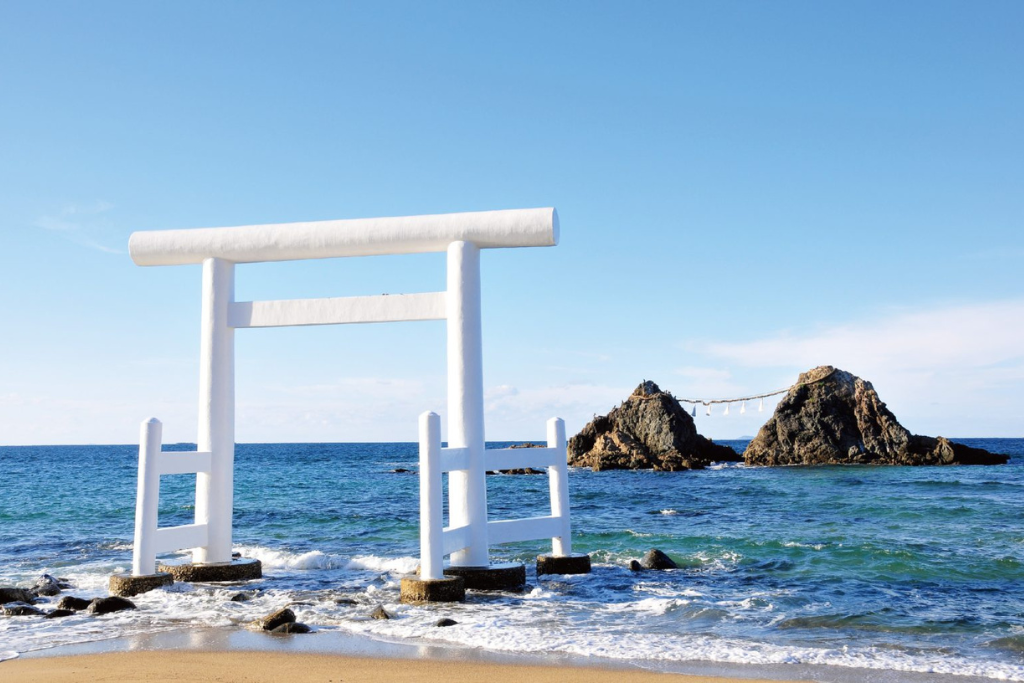
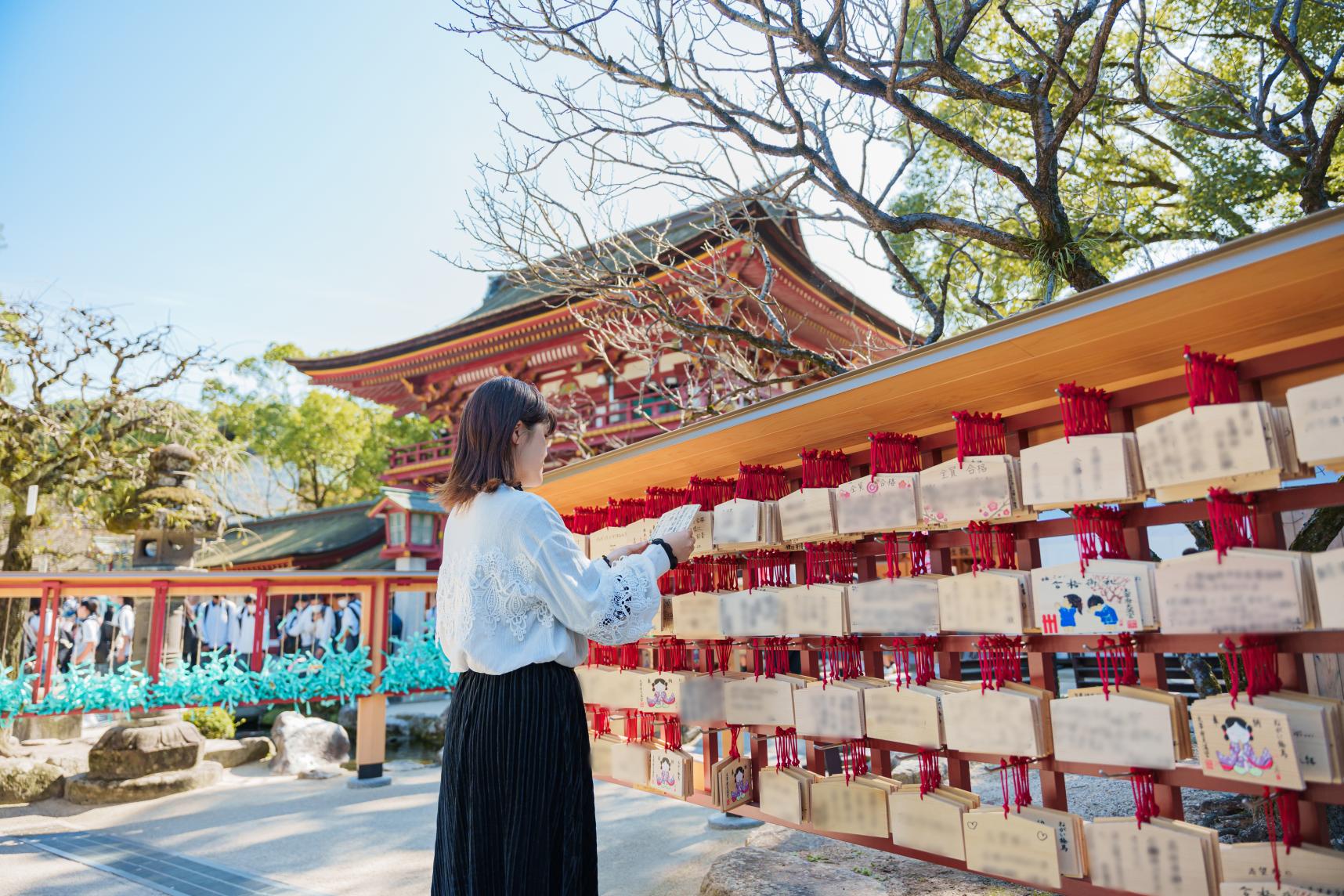
![[2024 Edition] Filled with blessings! The ultimate Fukuoka power spots to bring you happiness.-1](https://www.crossroadfukuoka.jp/storage/special_features/320/responsive_images/6SsCvBDXBhlZoAGUgarTOpZpEaEwsIqsWzSxW8cw__1289_856.png)